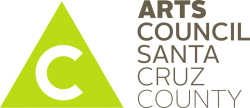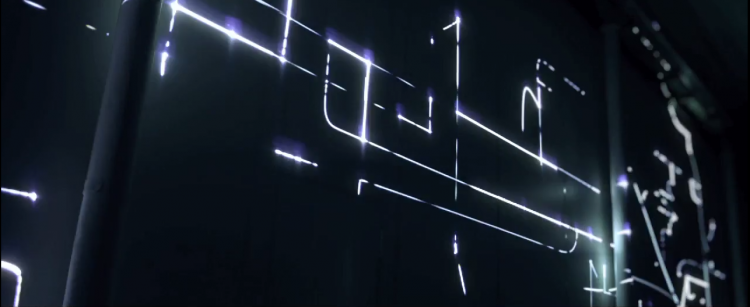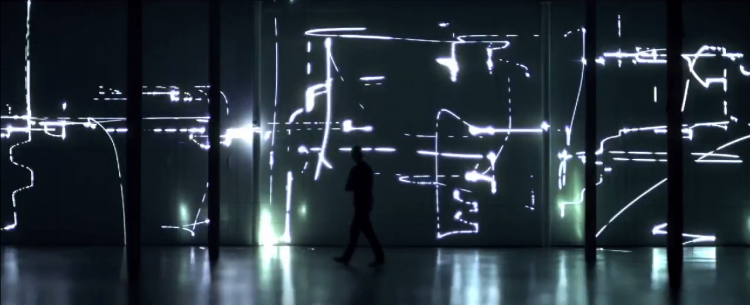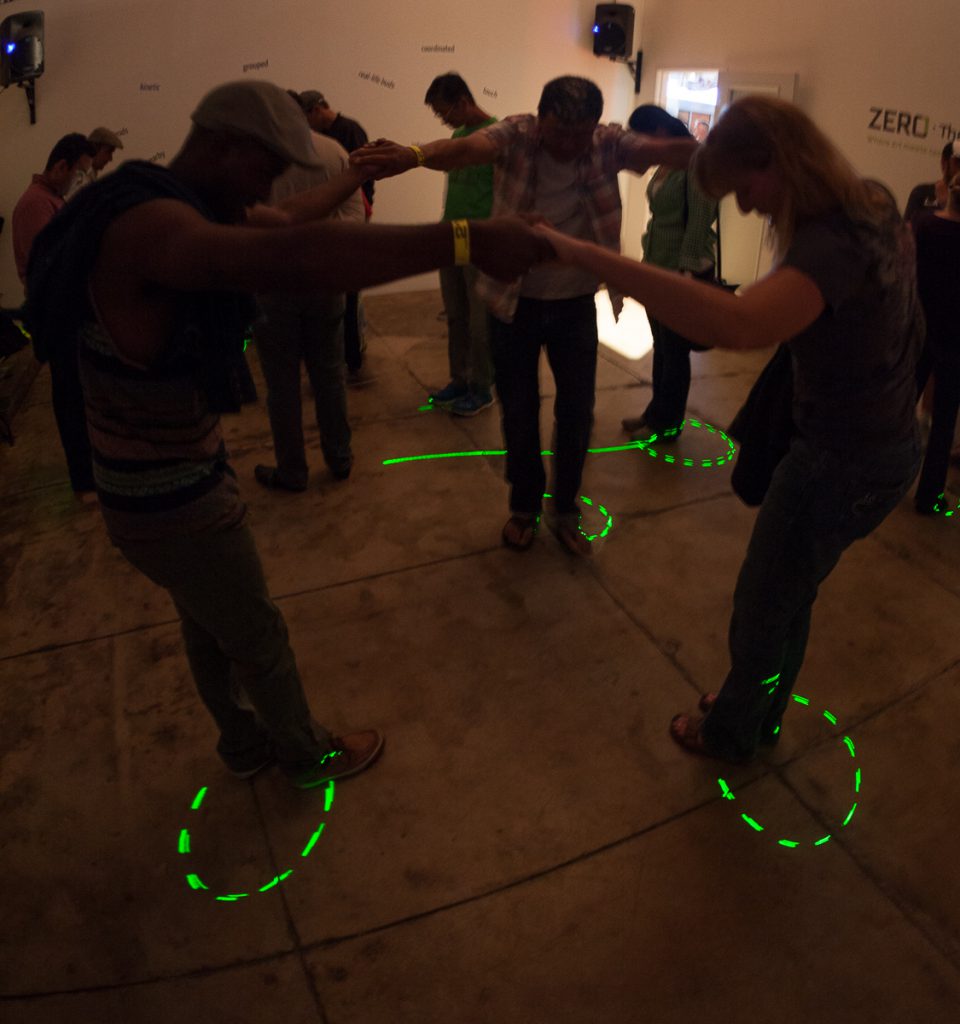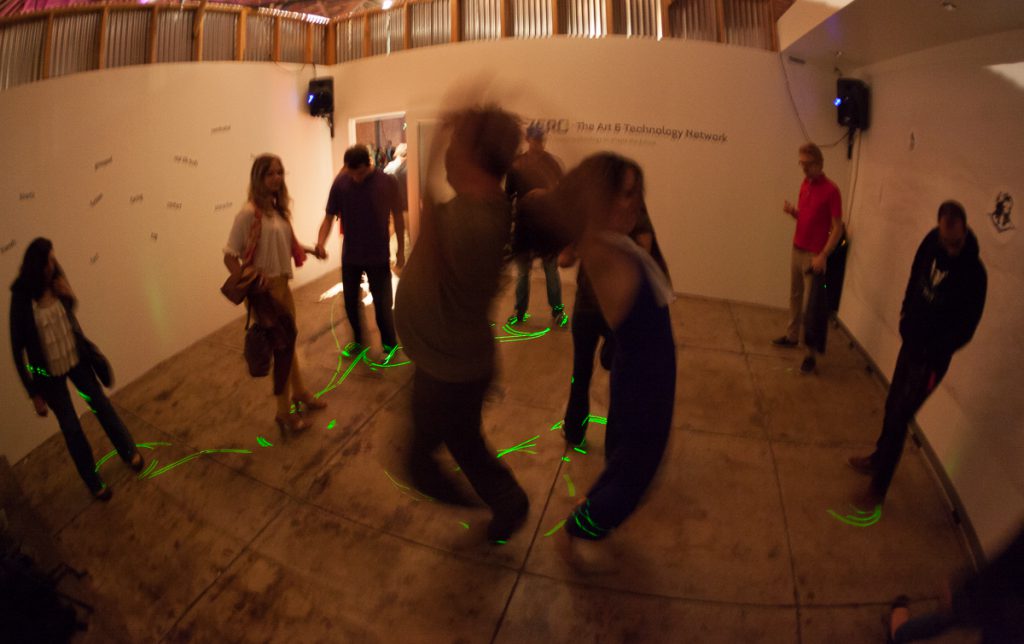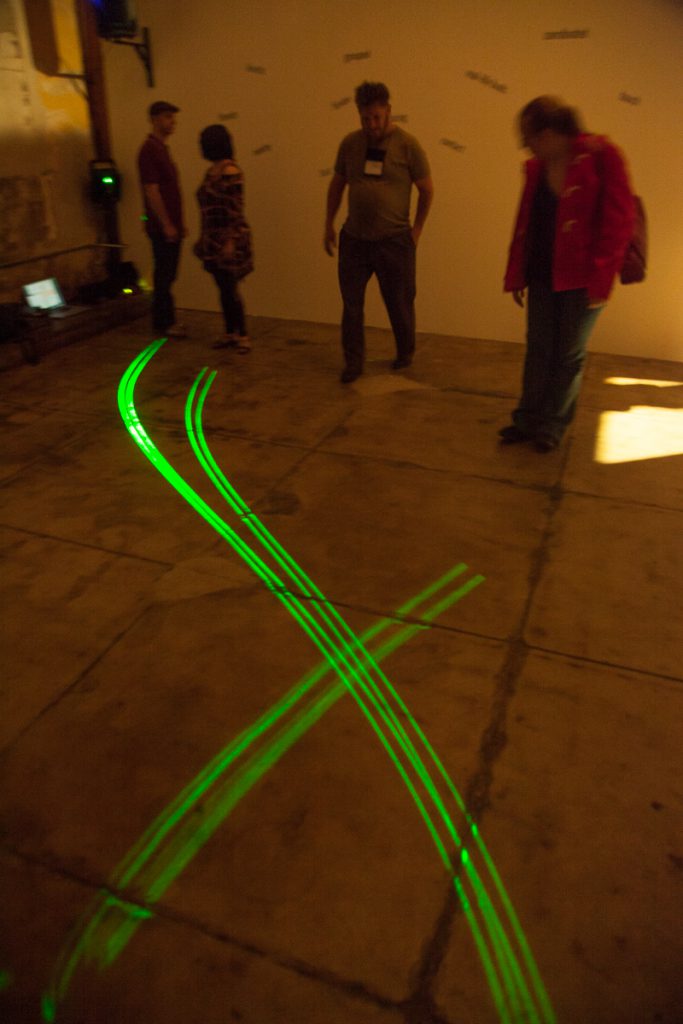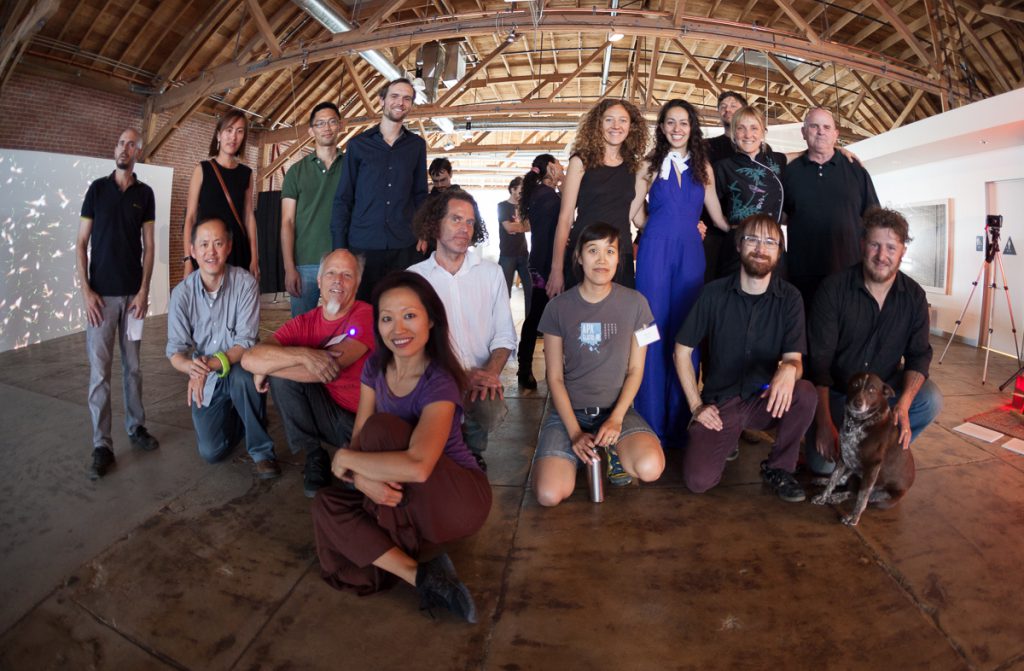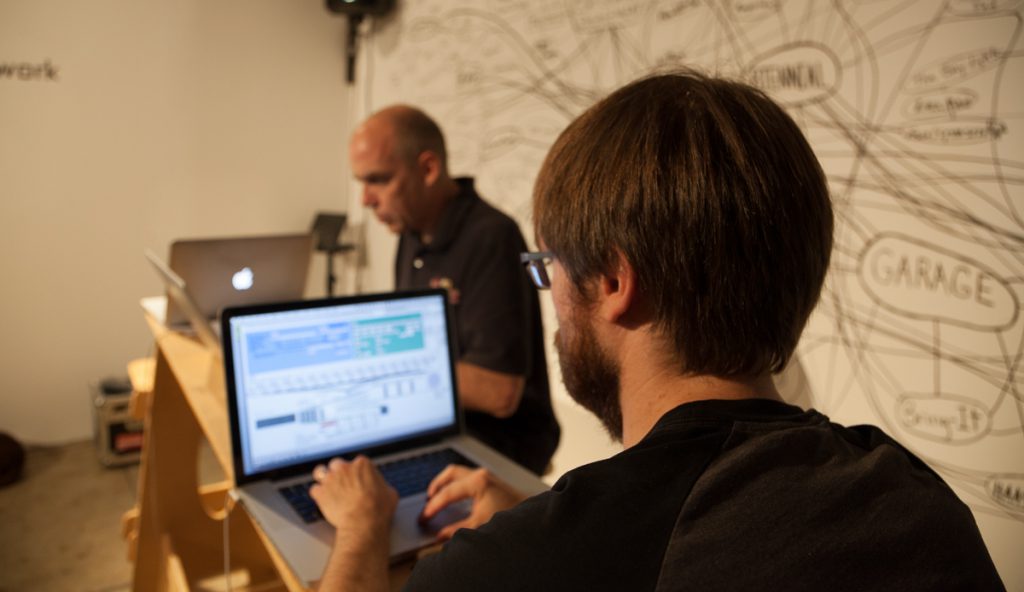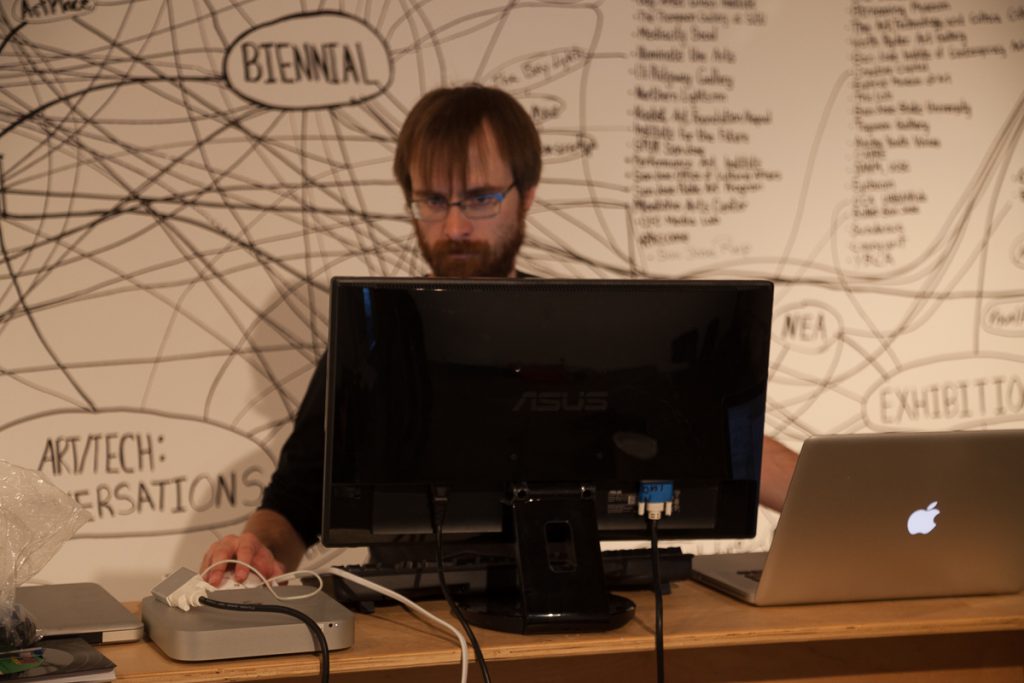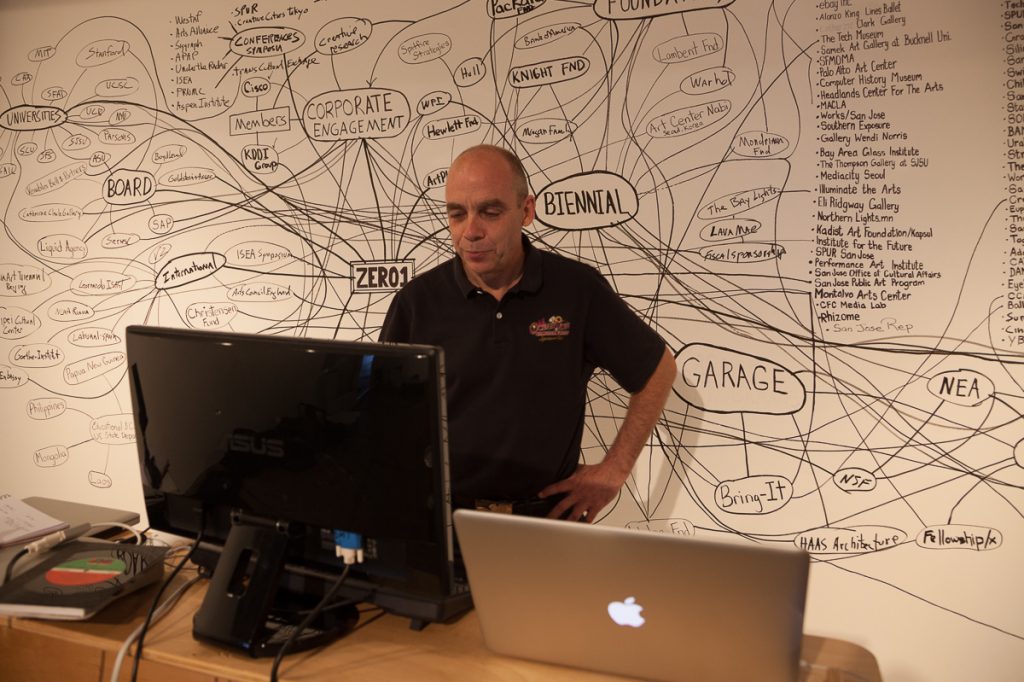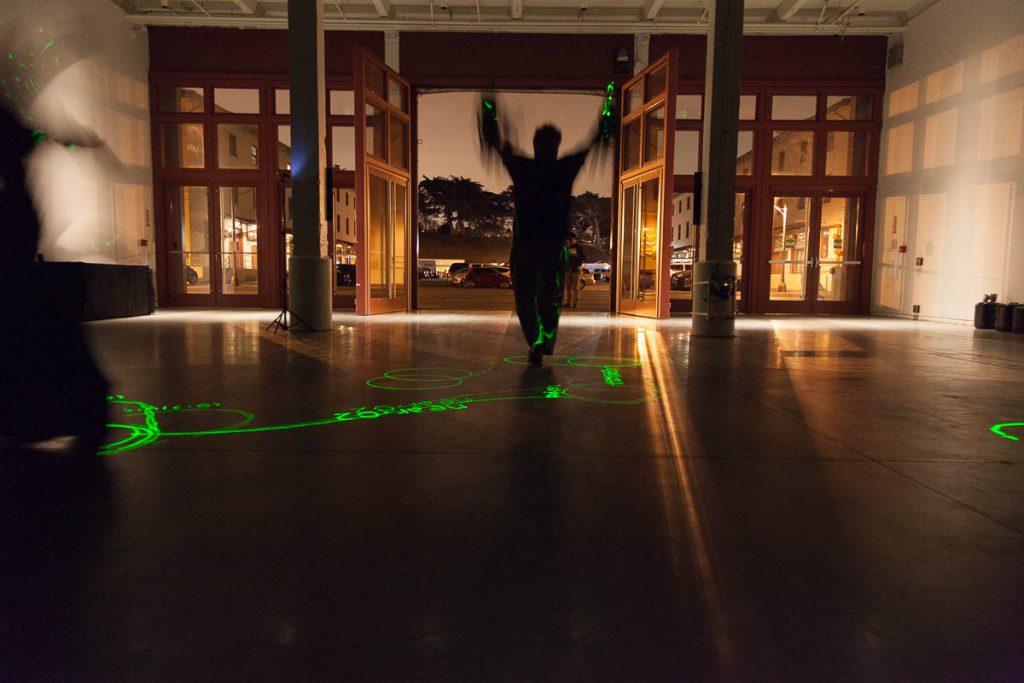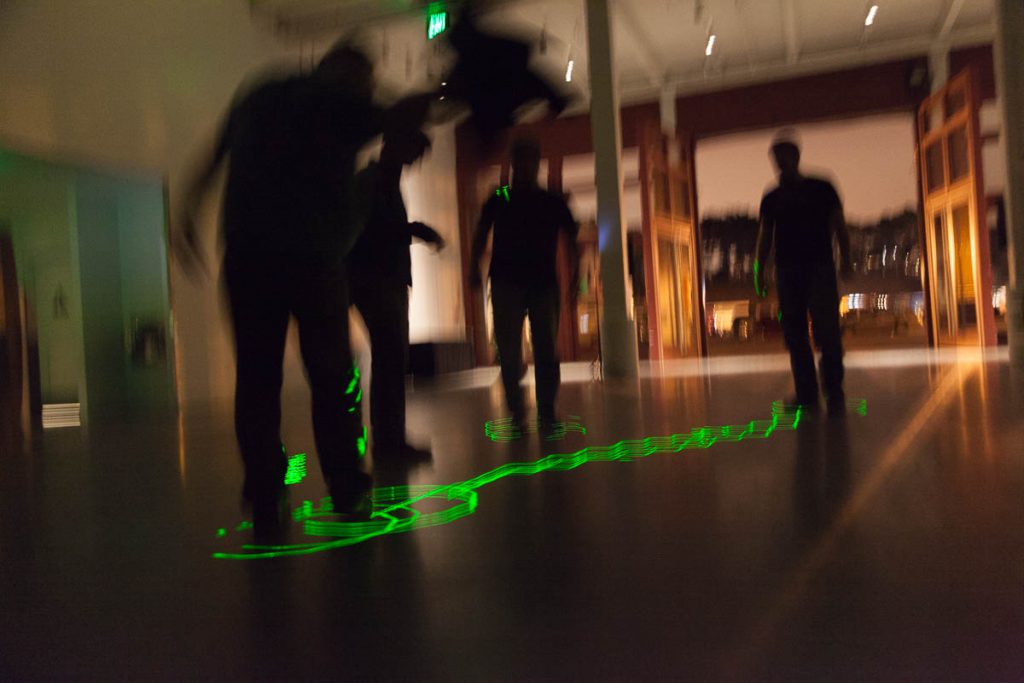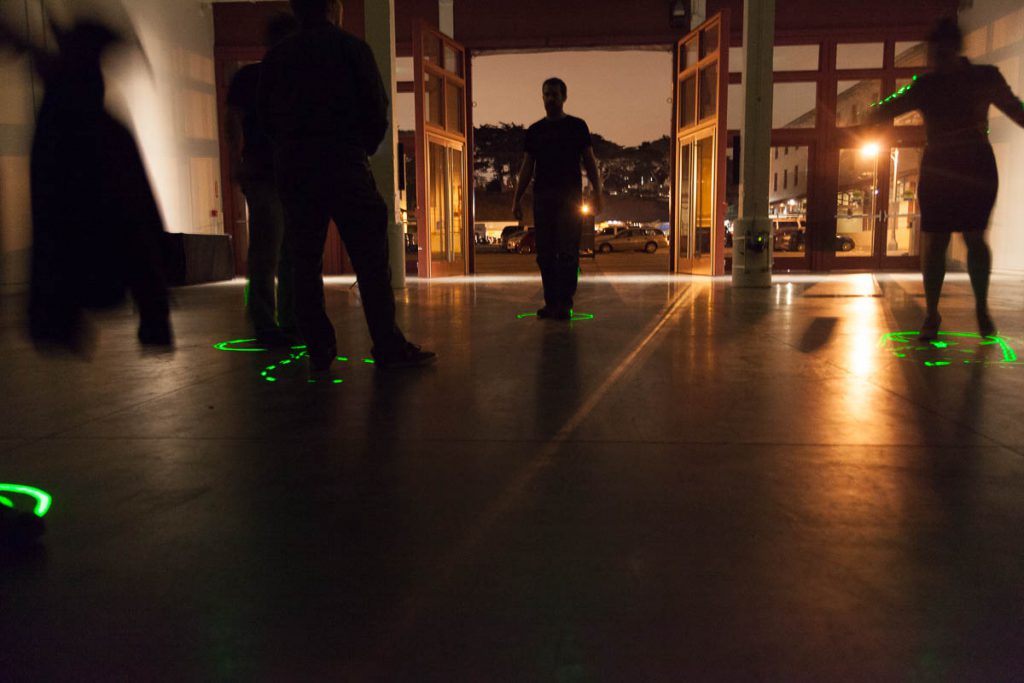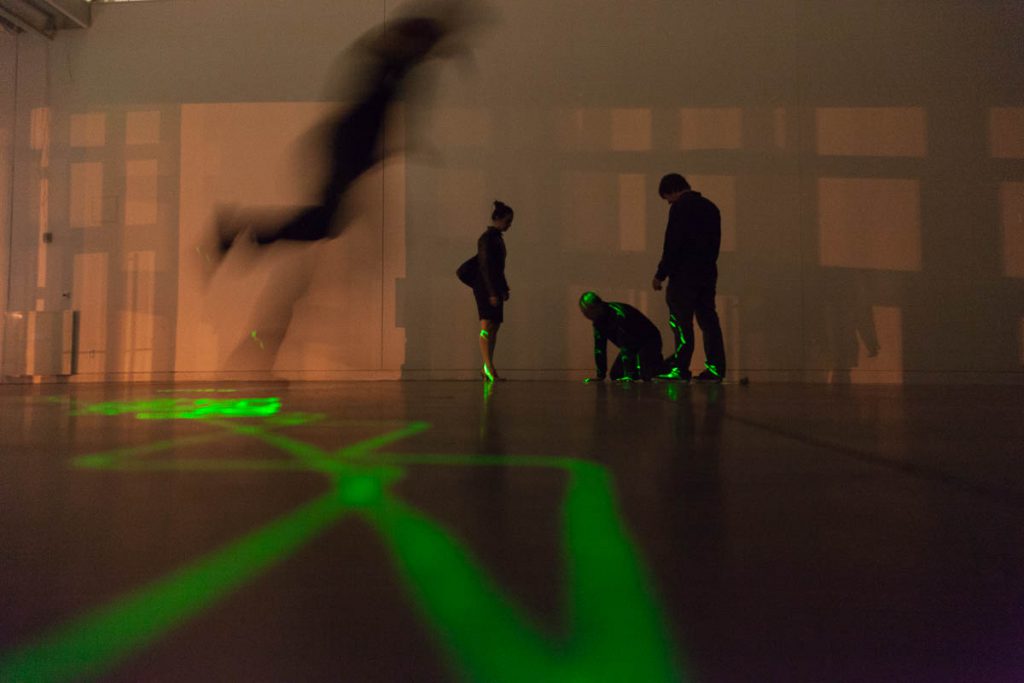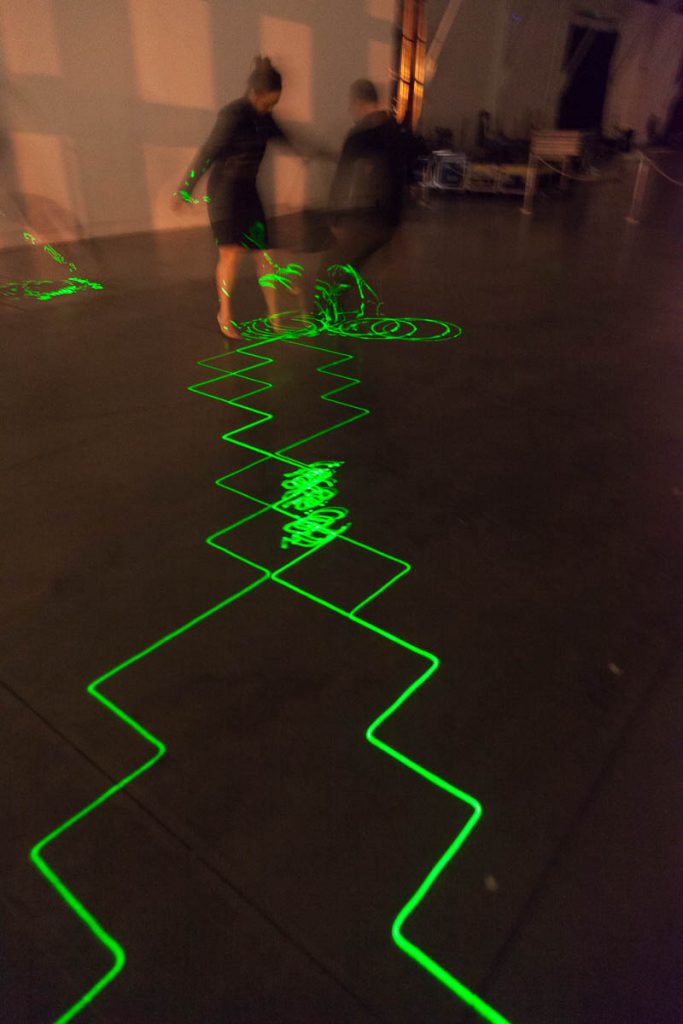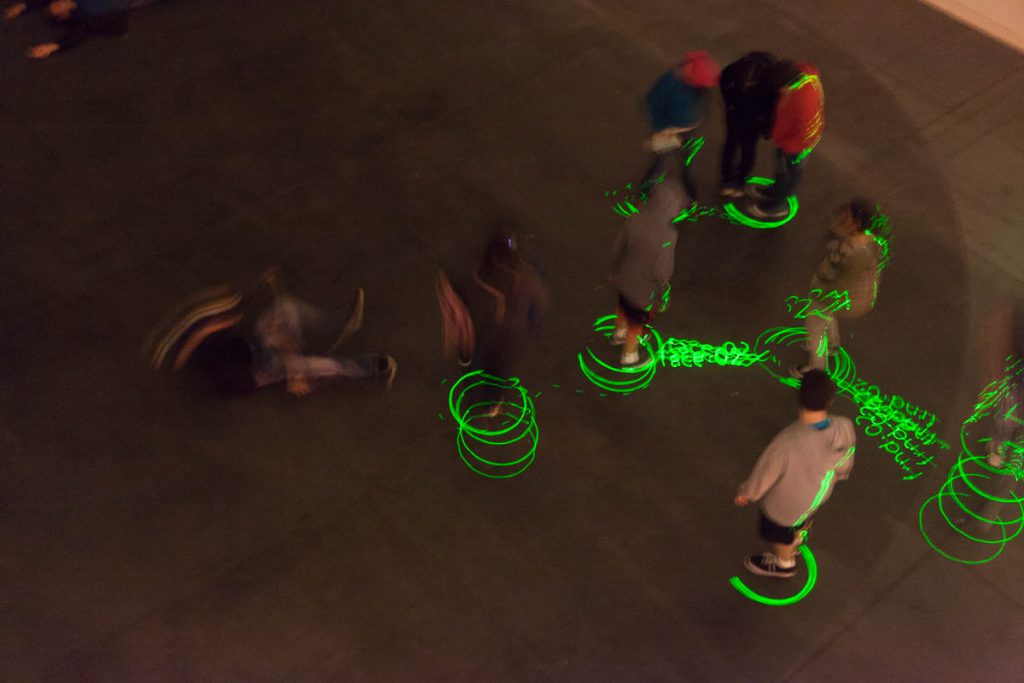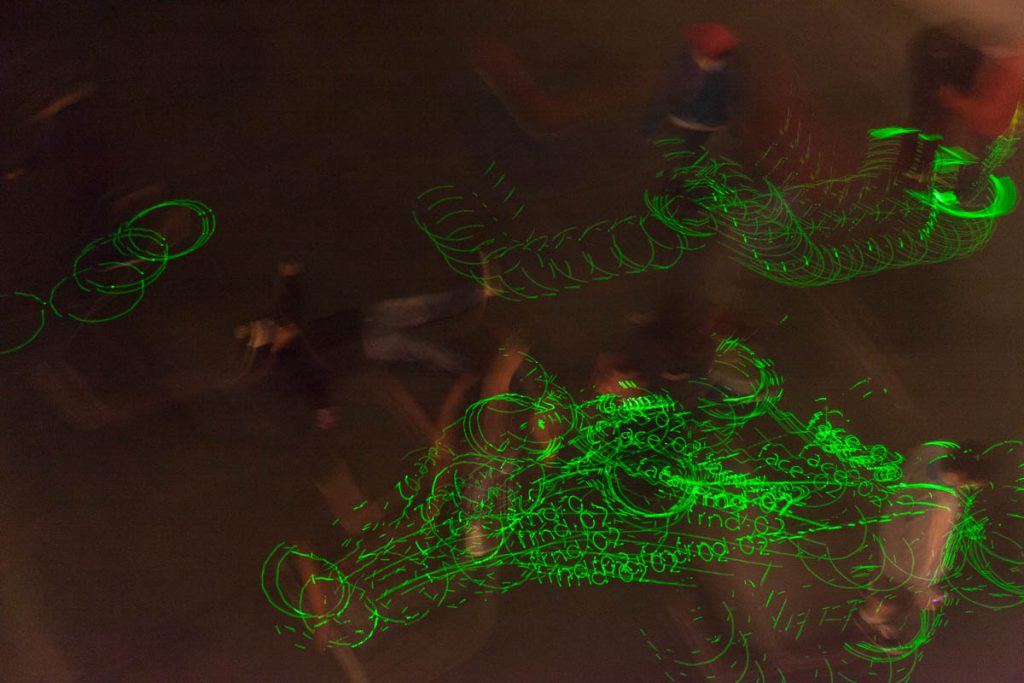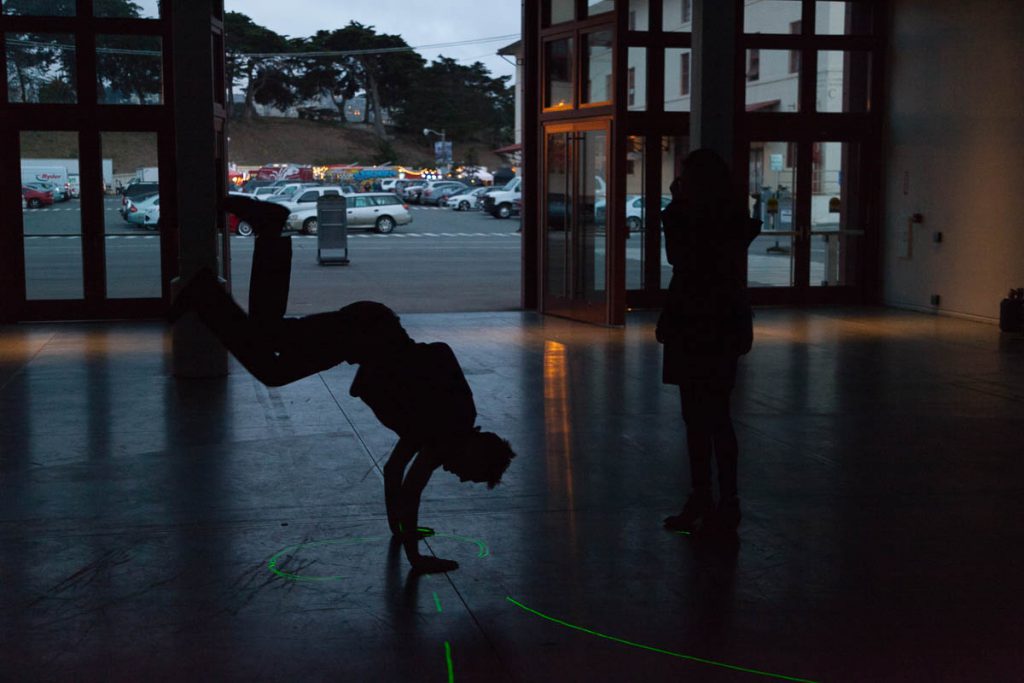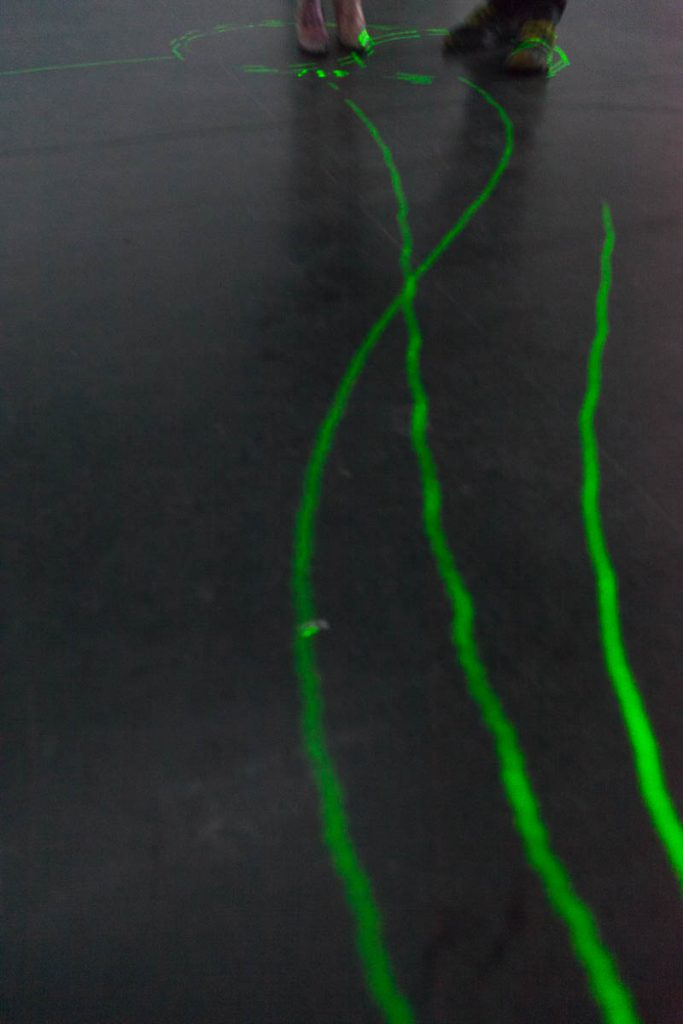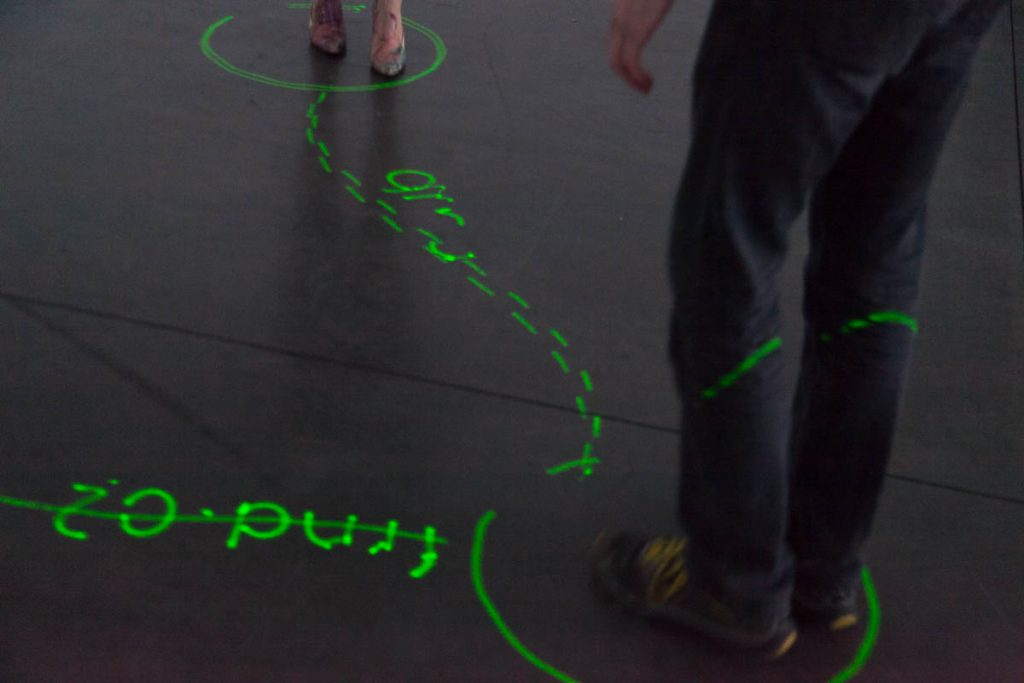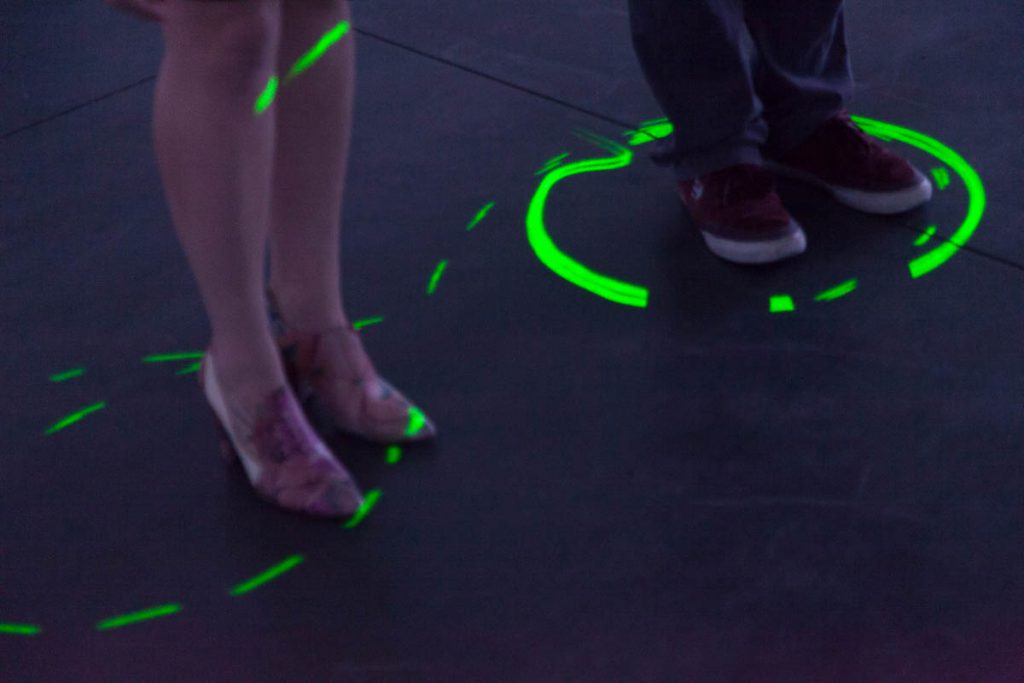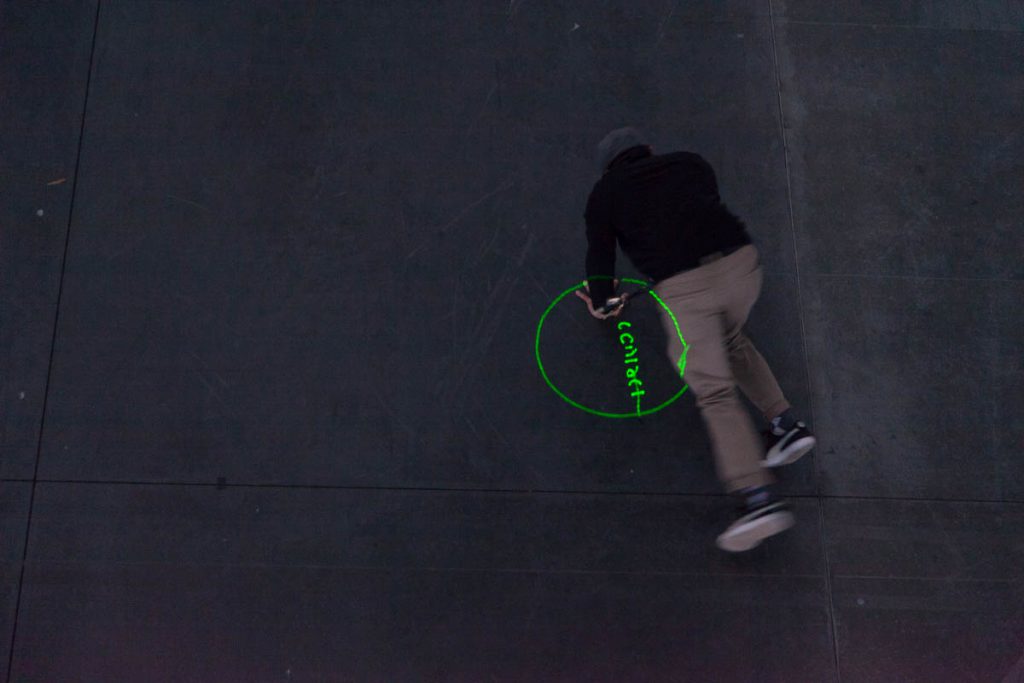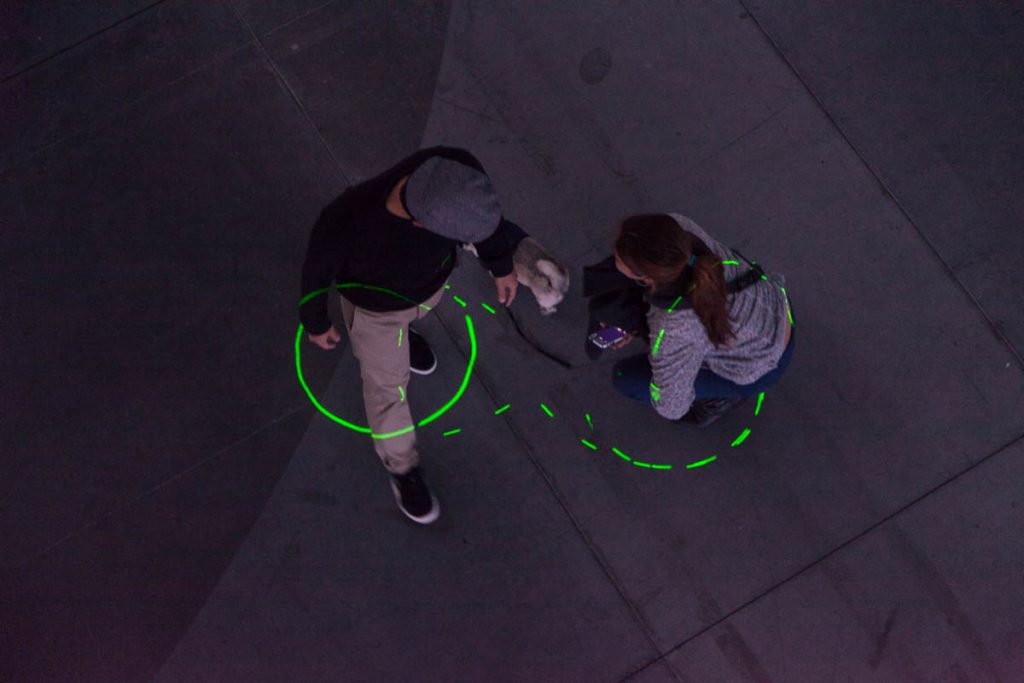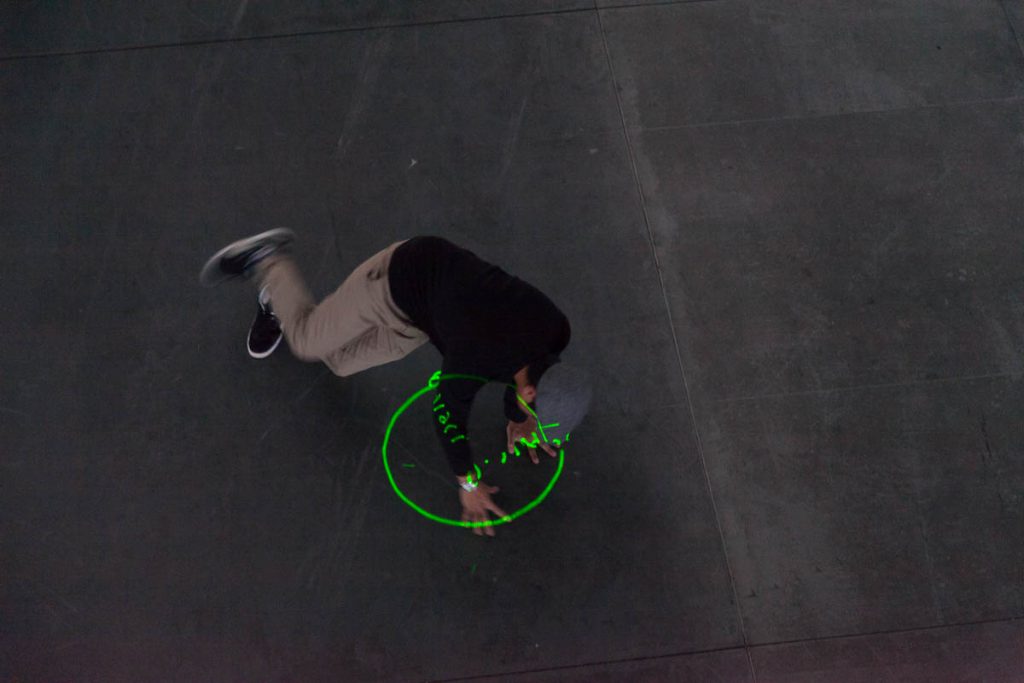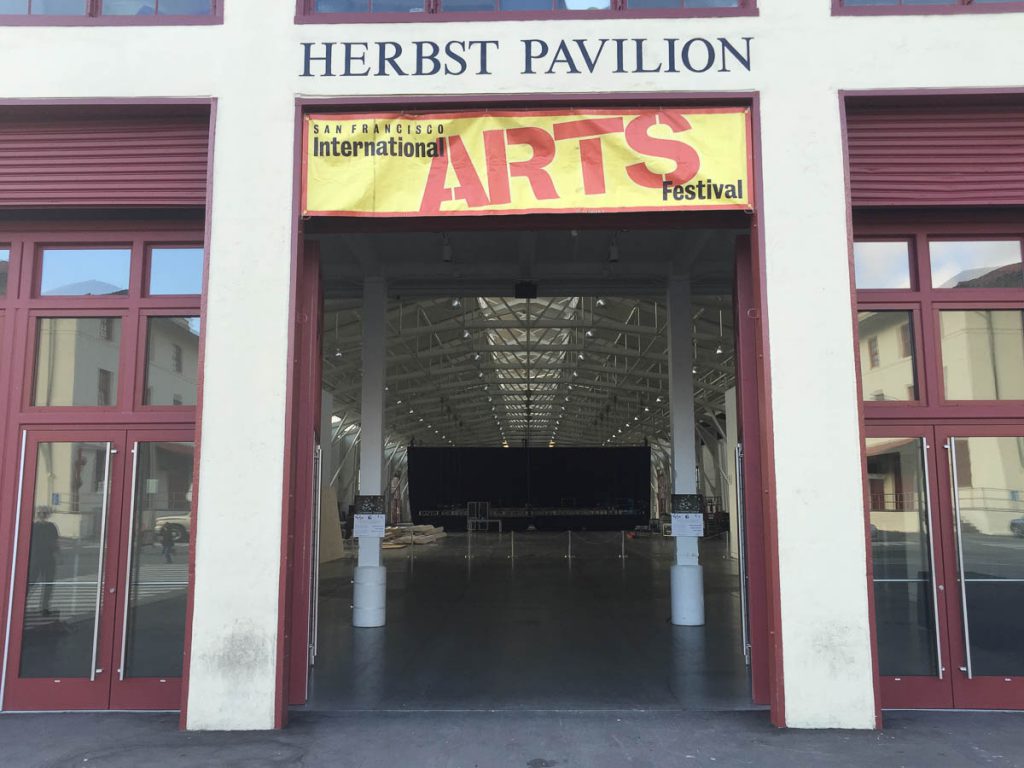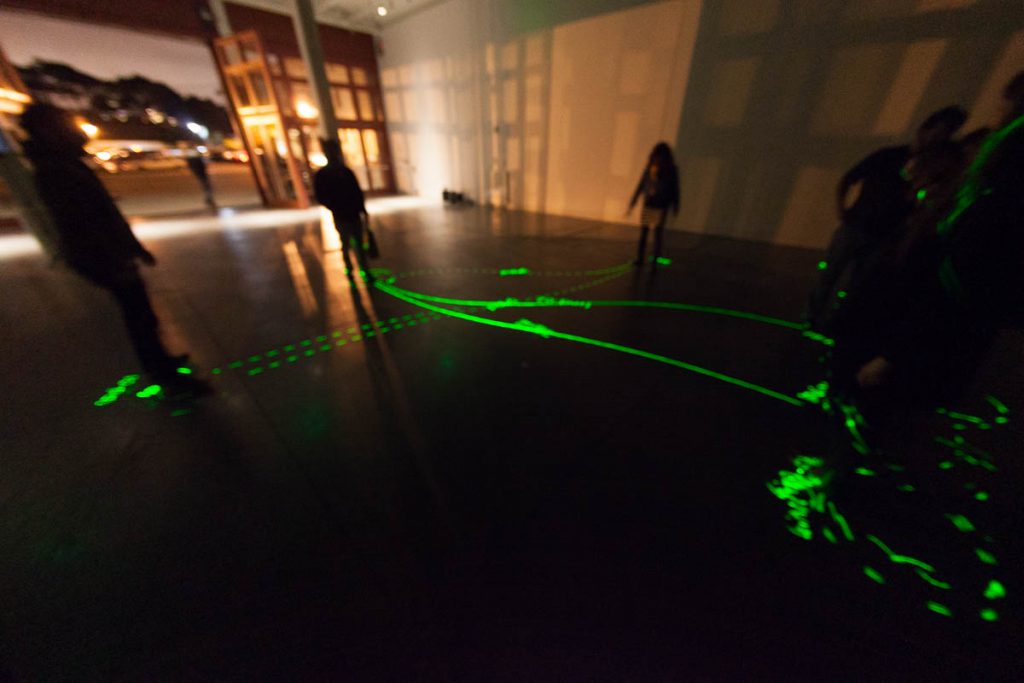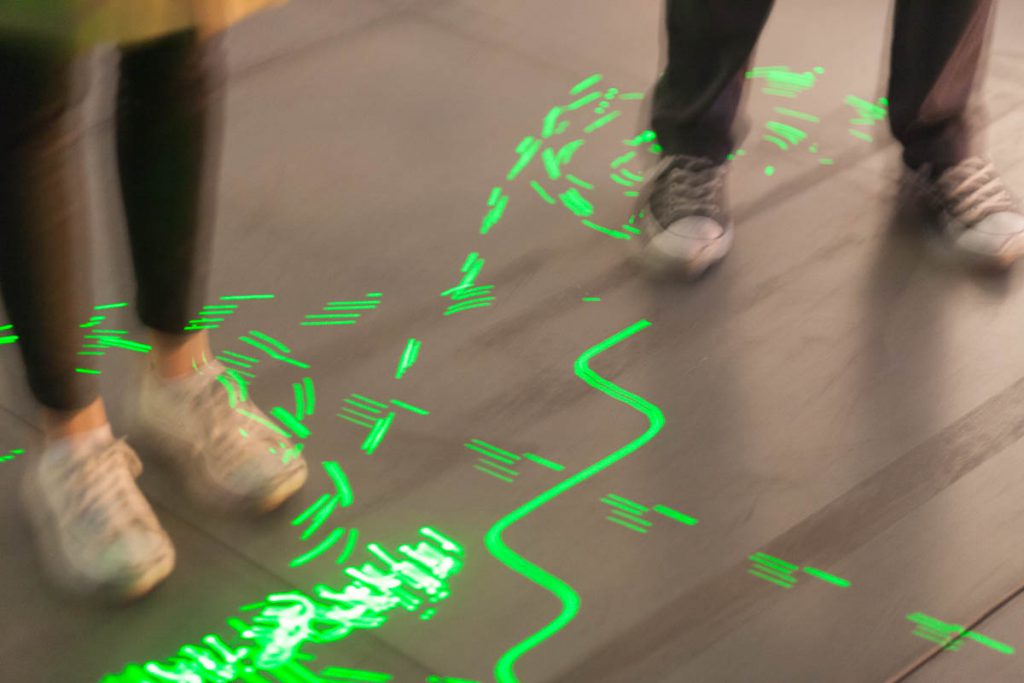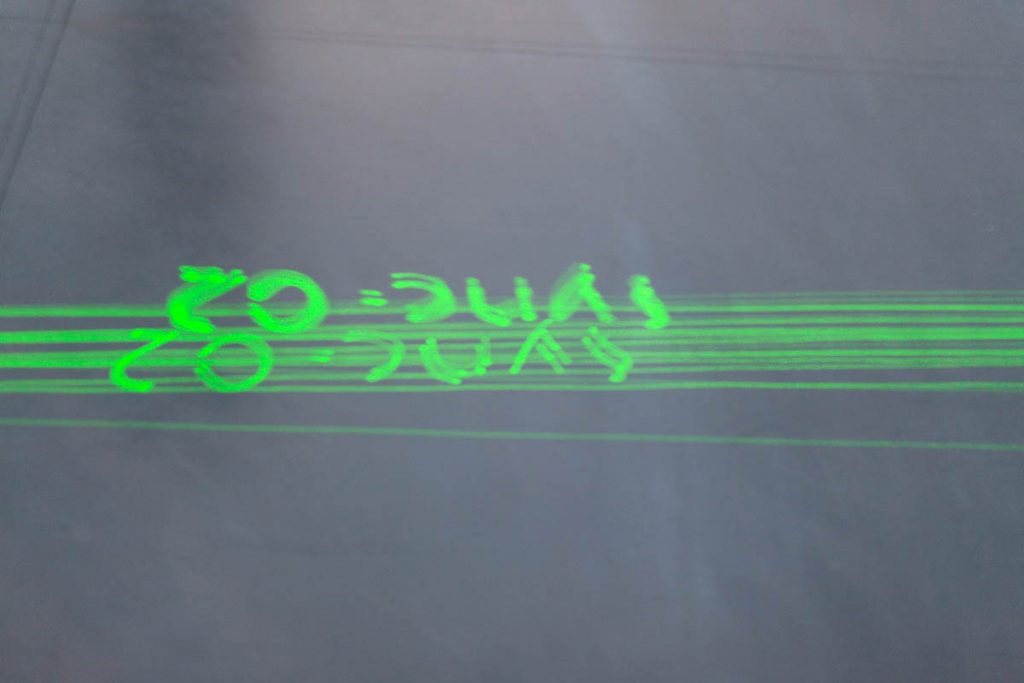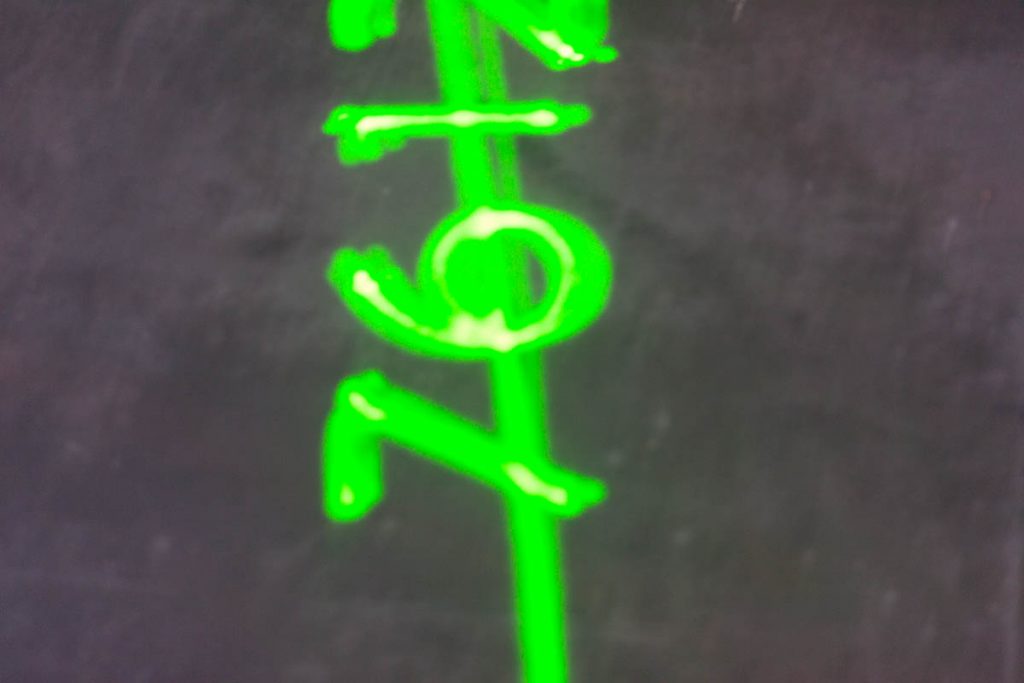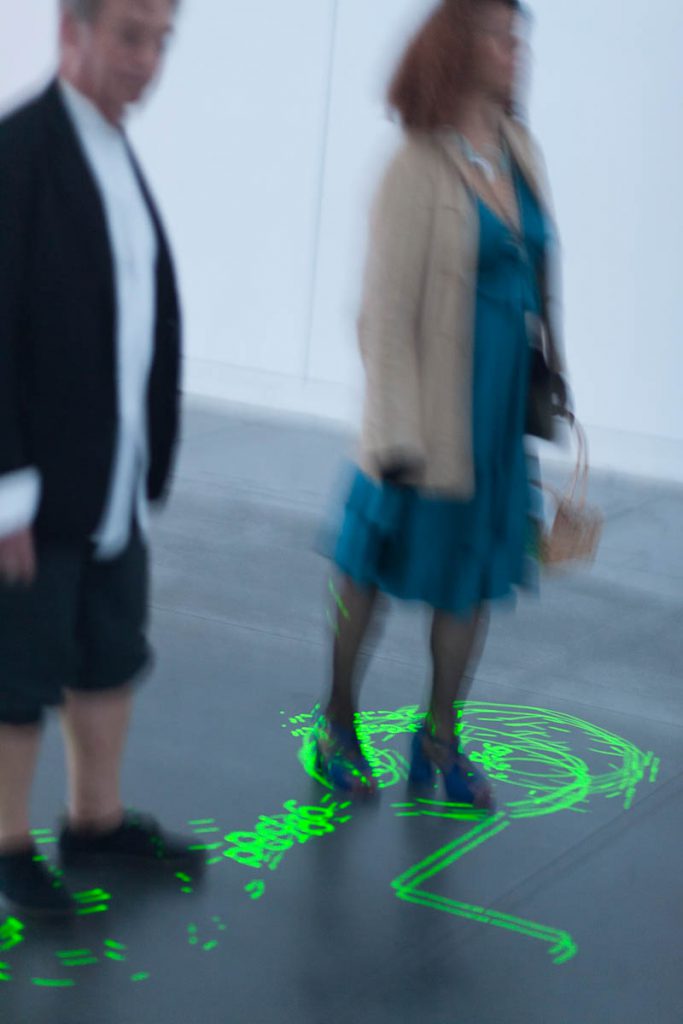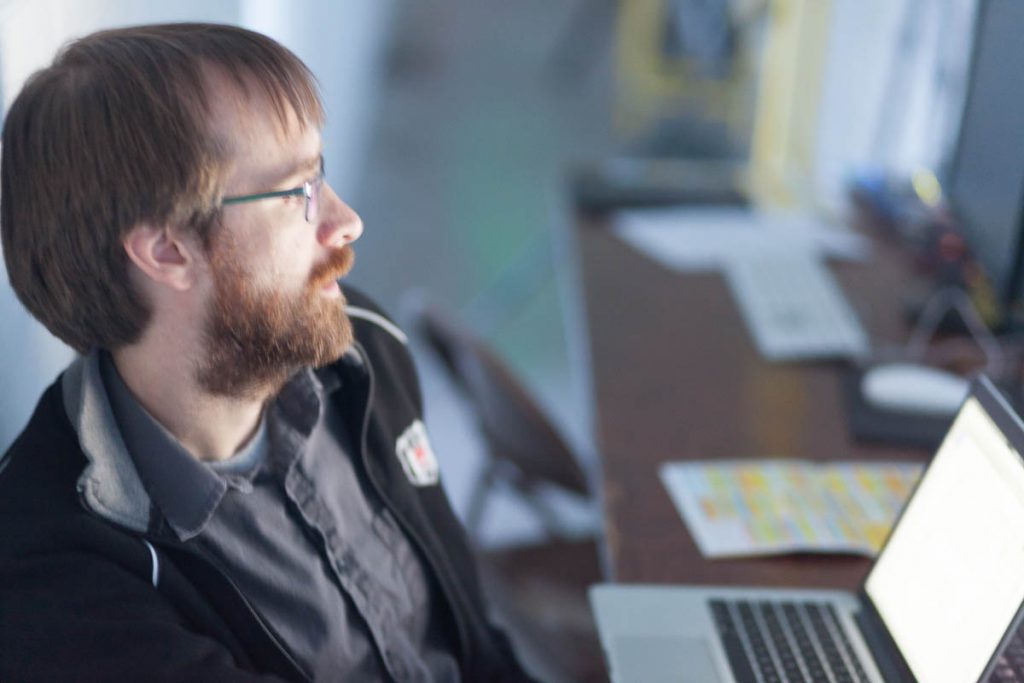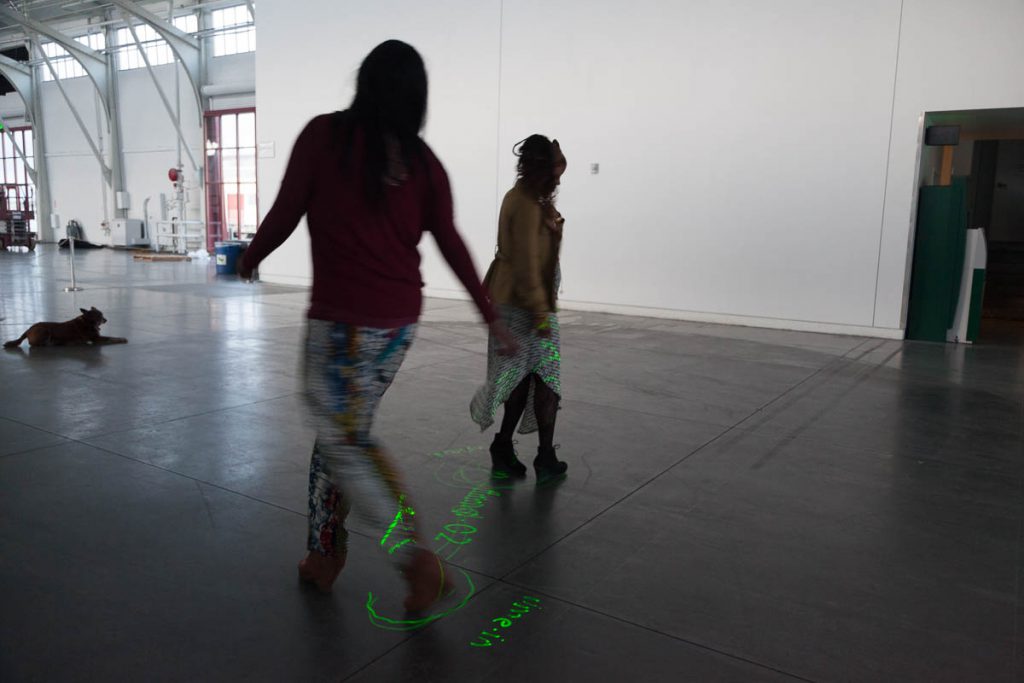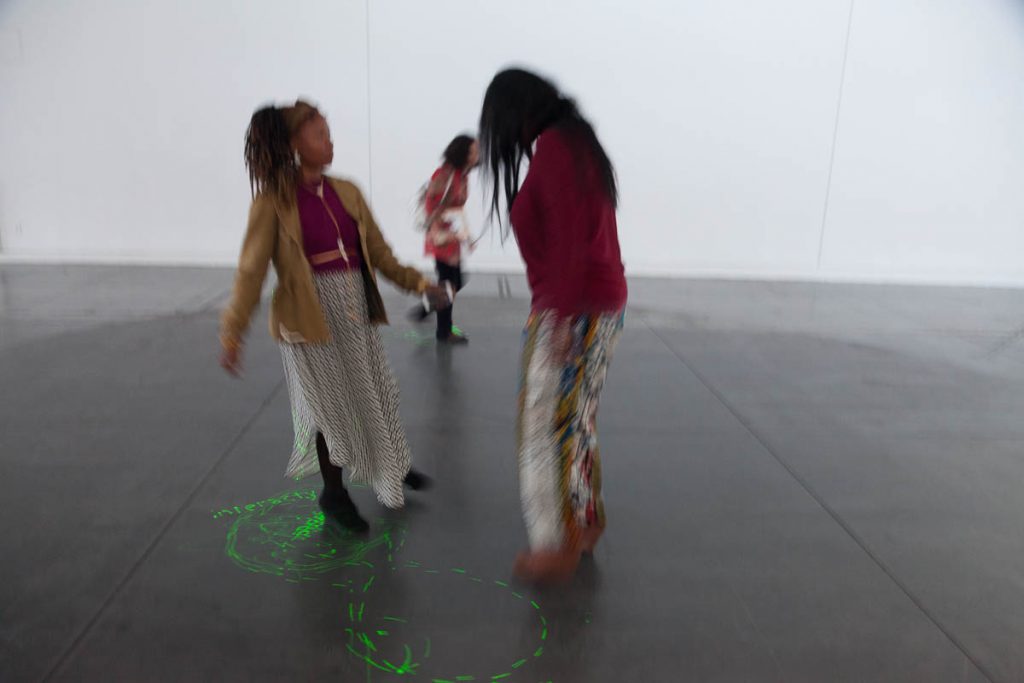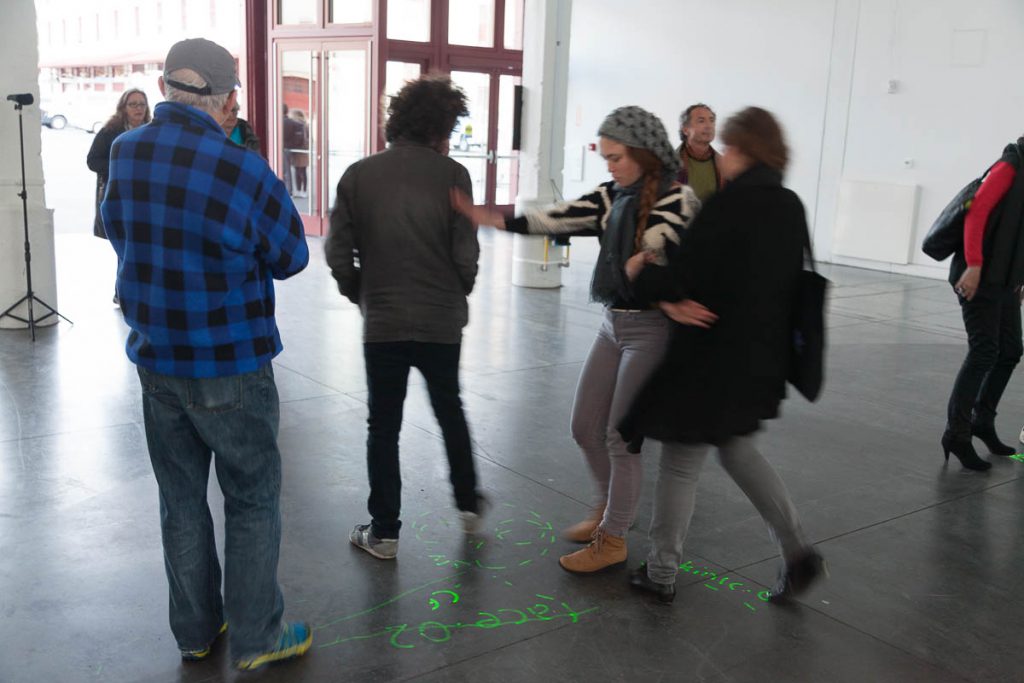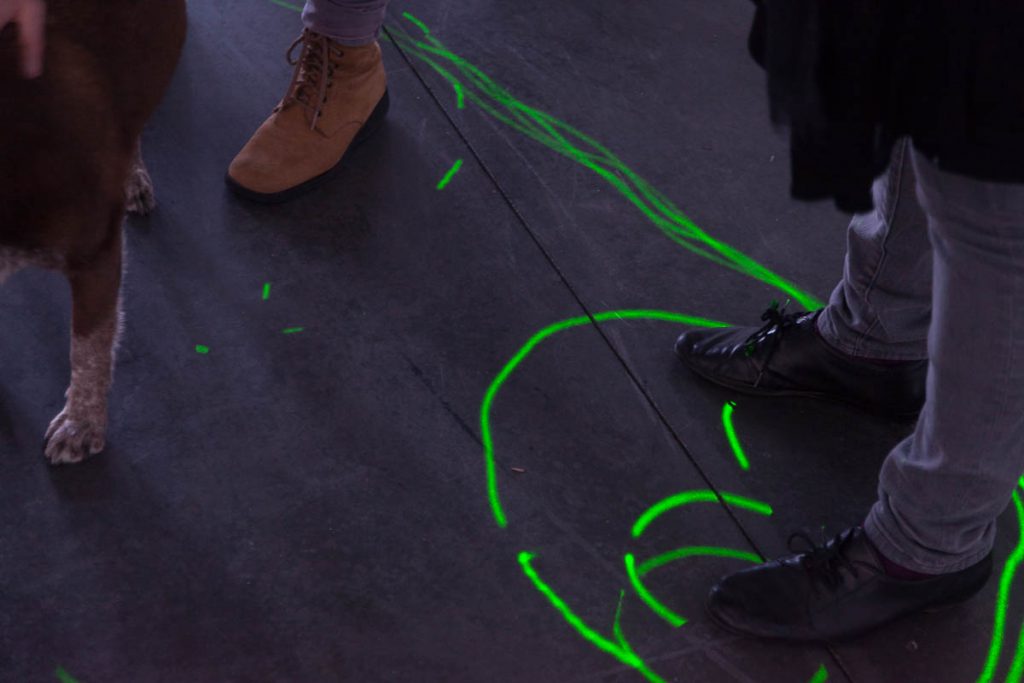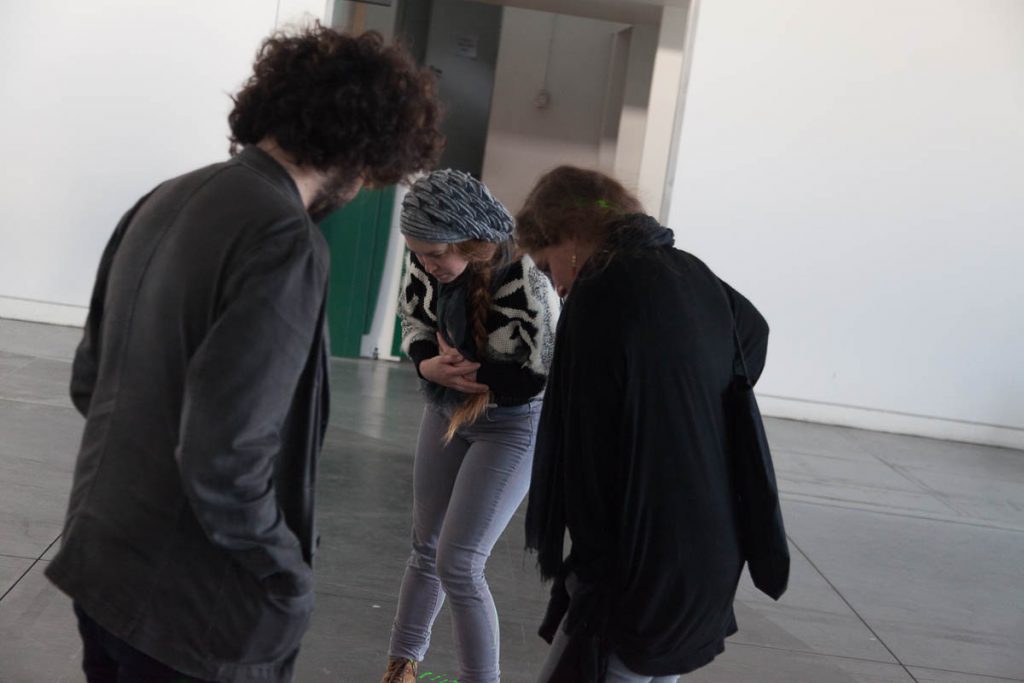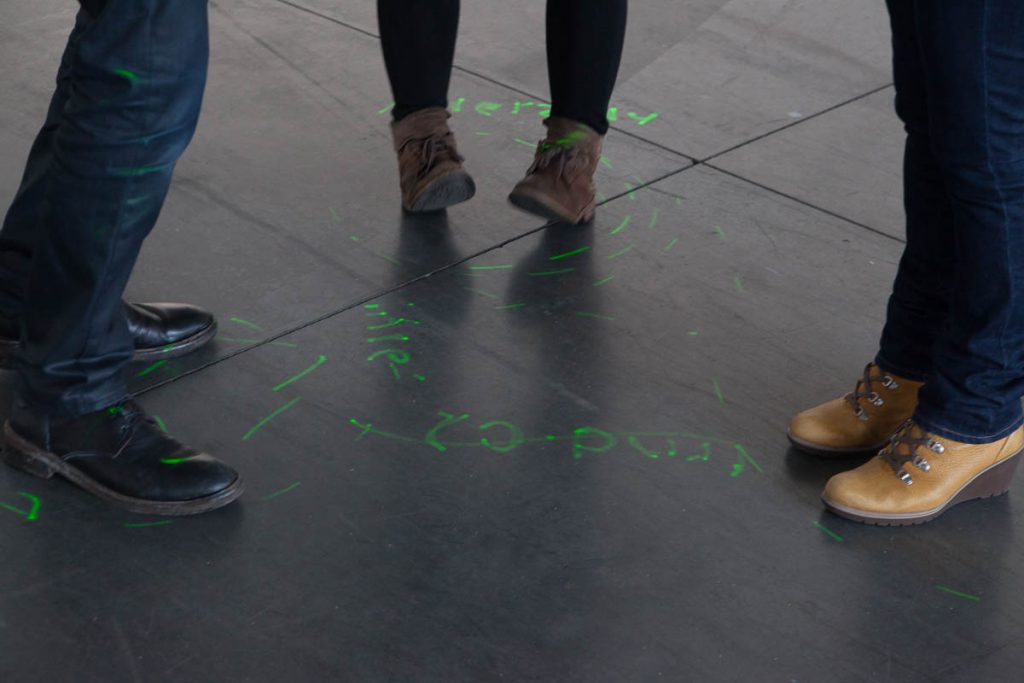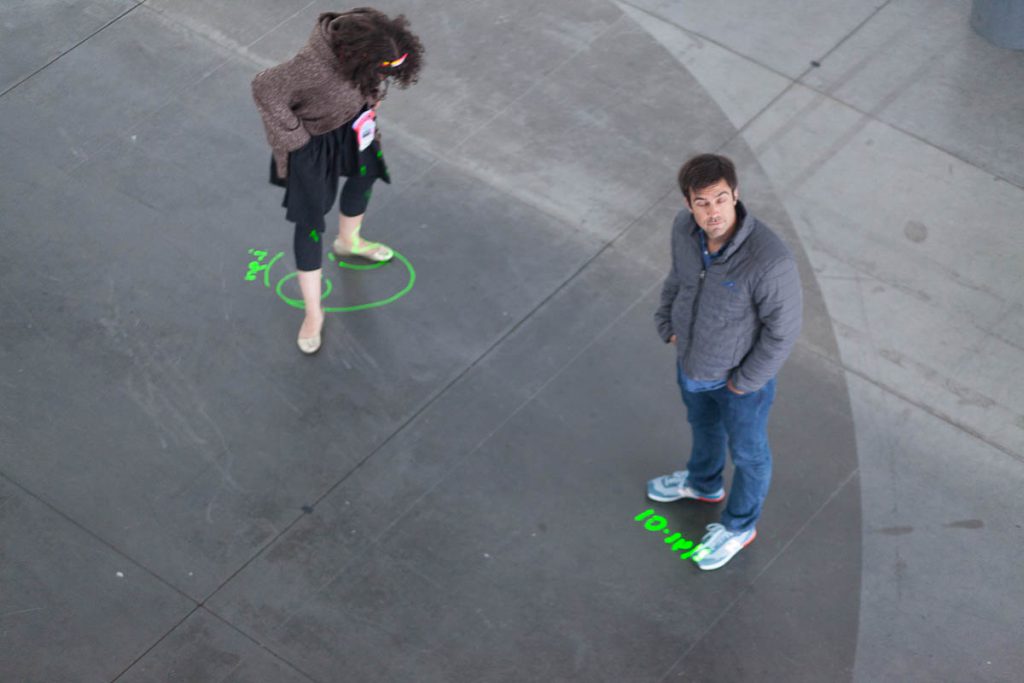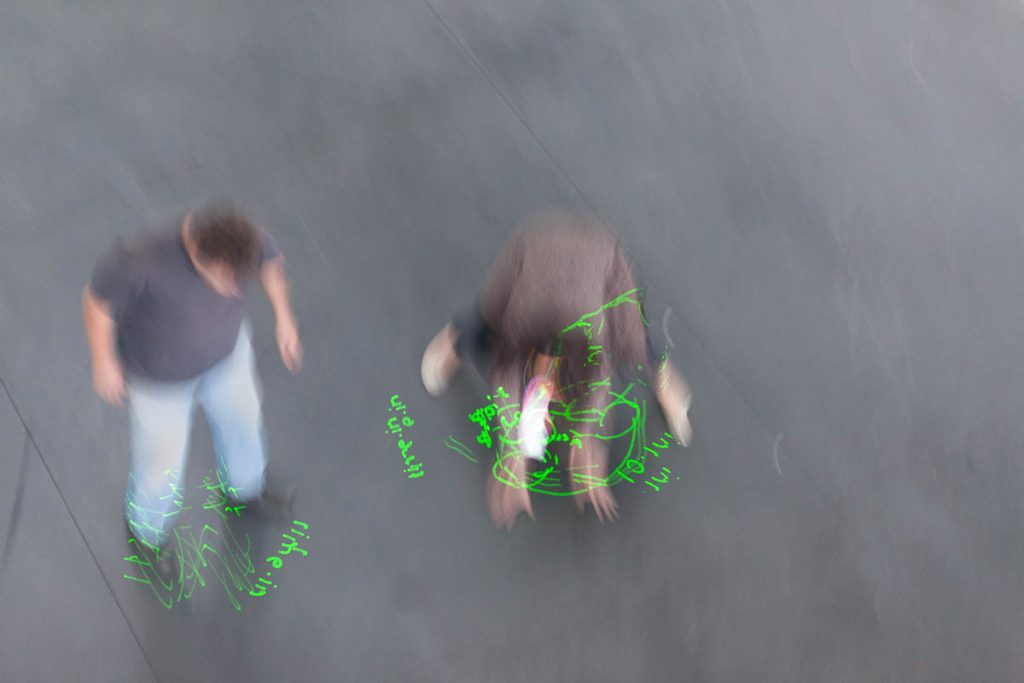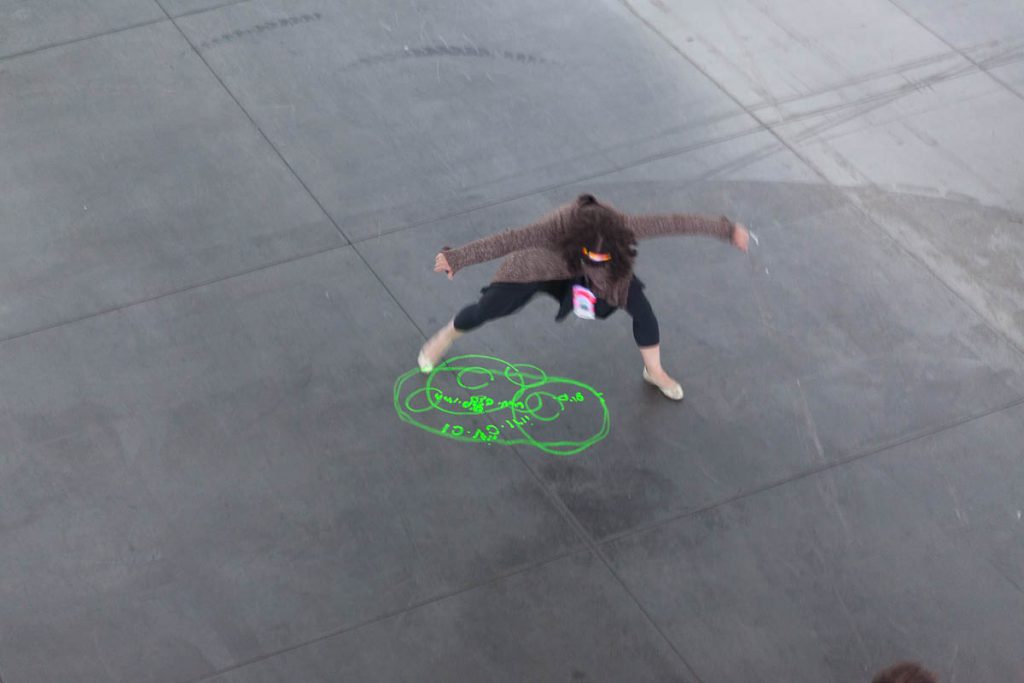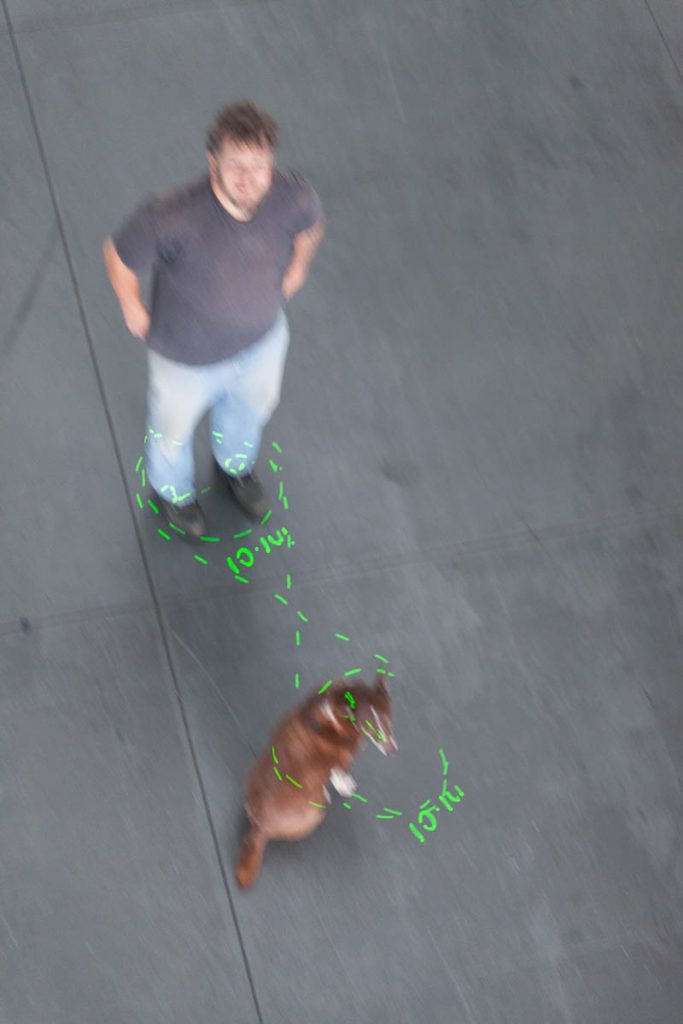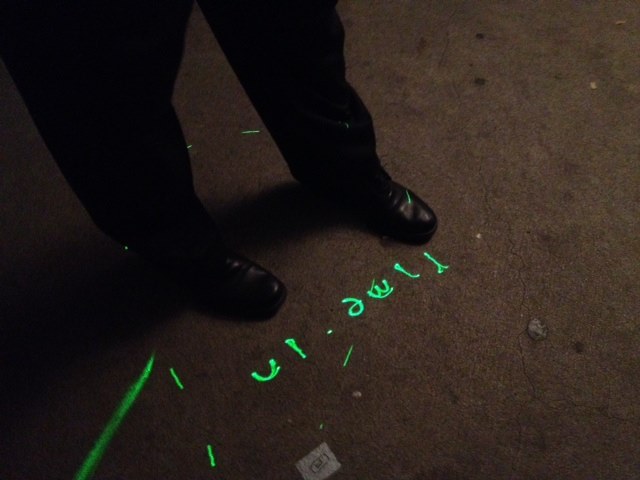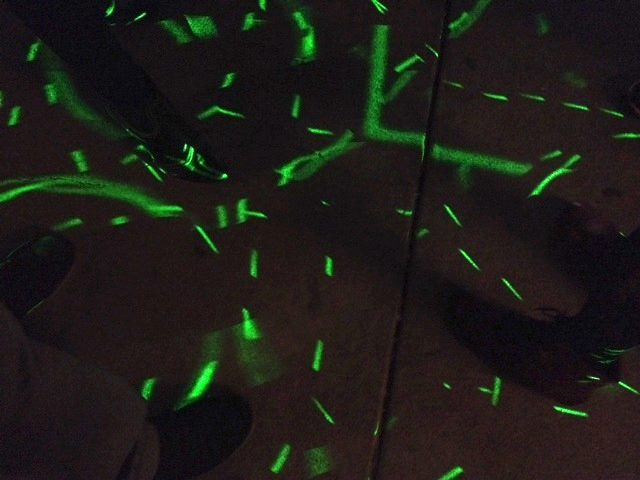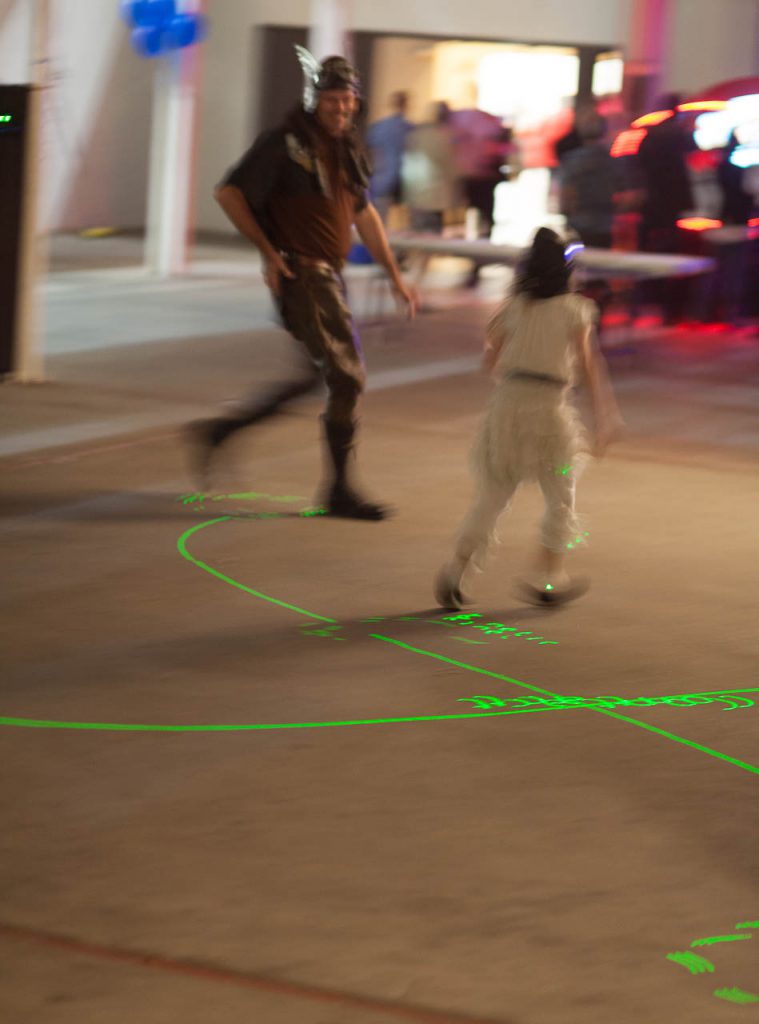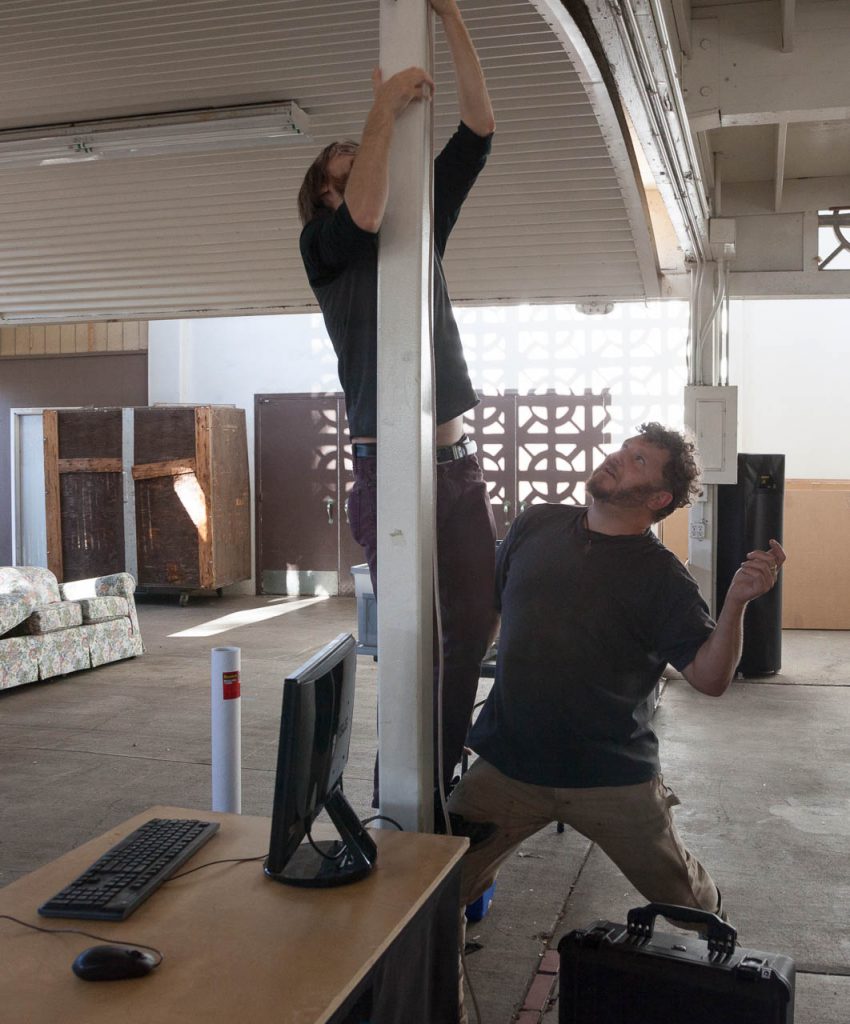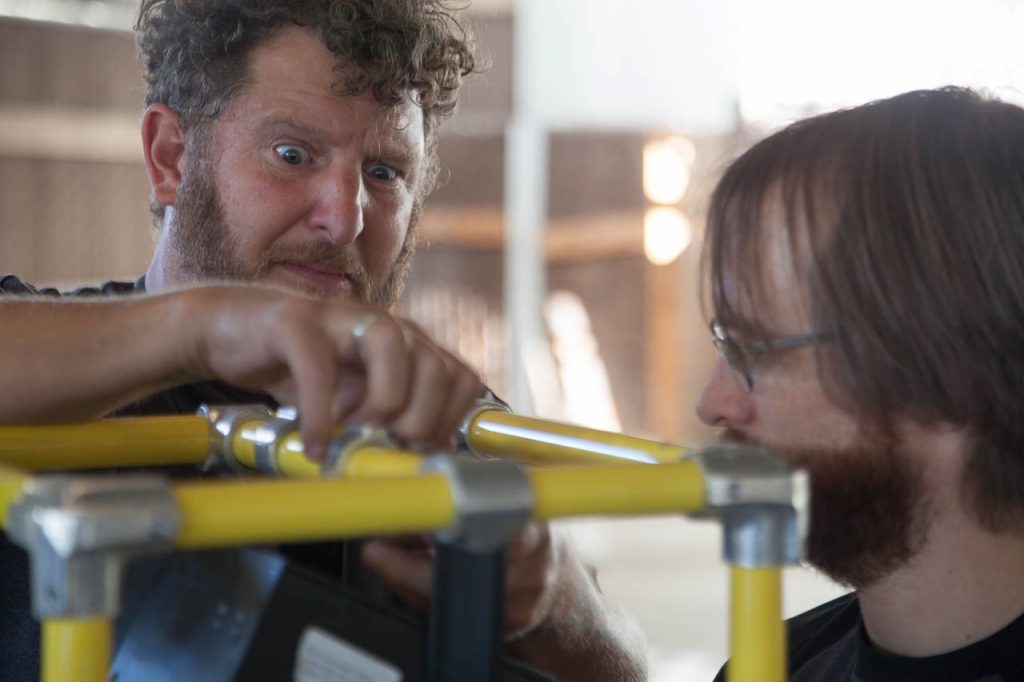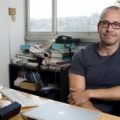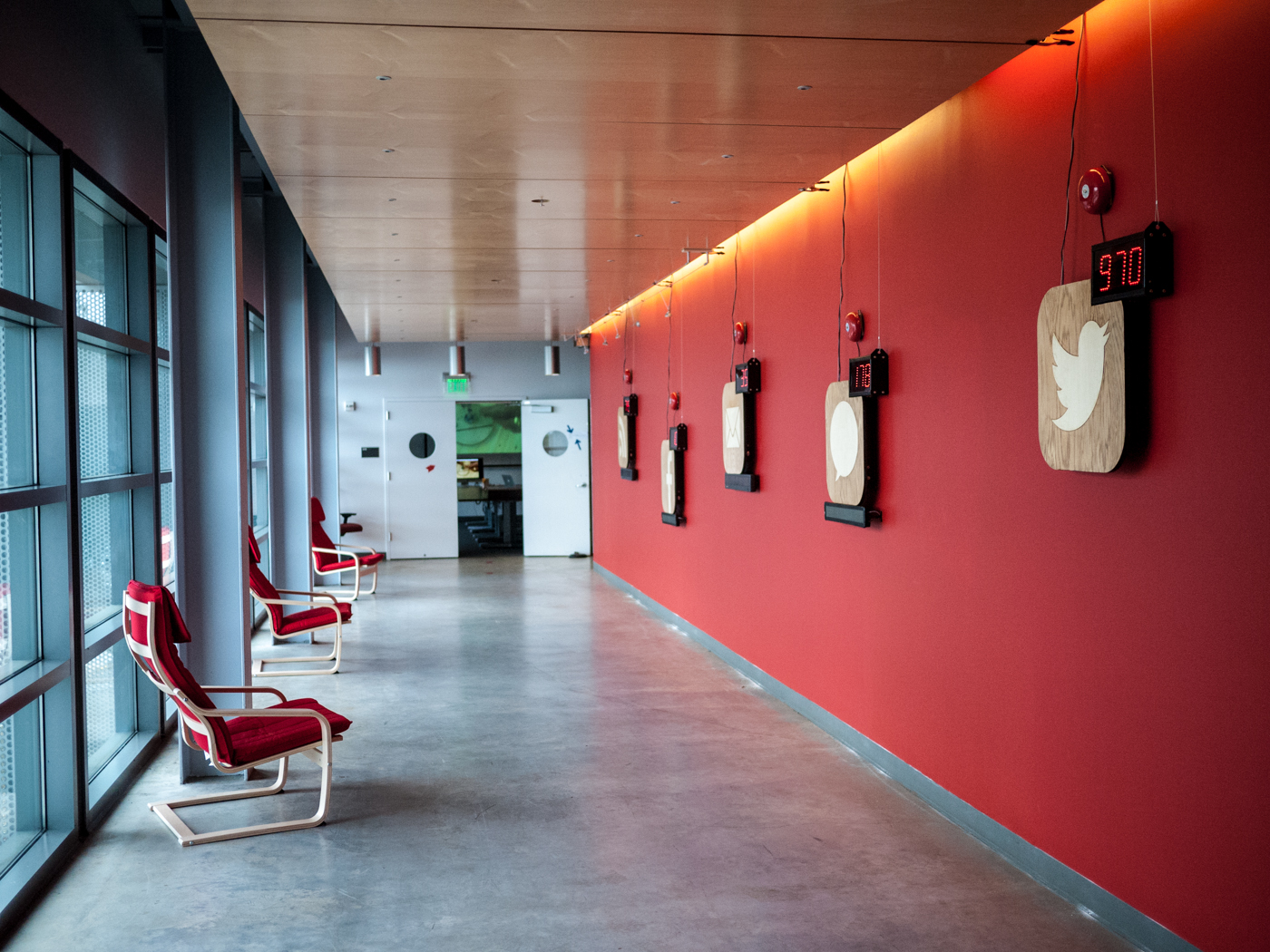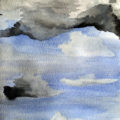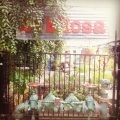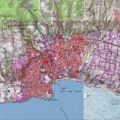A Playful Engagement with Light and Sound in Public Space
Visit the website at CORELATEDSPACE.COM
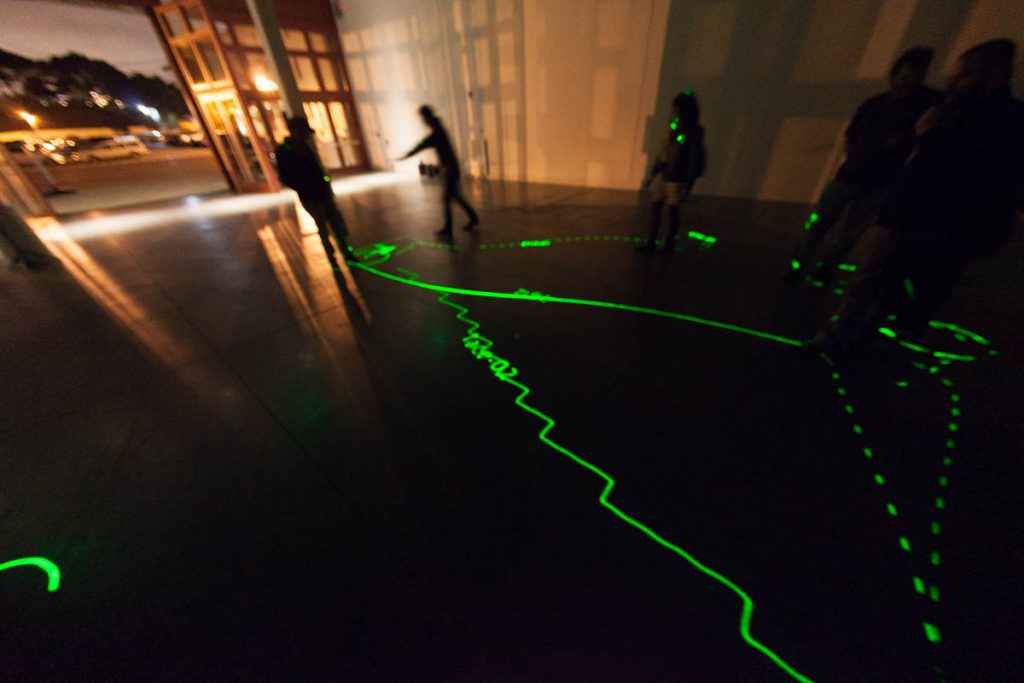
Primary Artists:
Wes Modes, artist and UCSC arts researcher and MFA candidate (visual, data aggregation, lasers)
Lanier Sammons, Santa Cruz composer and CSUMB faculty (sound)
Brent Townshend, Menlo Park artist, engineer, and inventor (motion tracking, lasers)
Proposal version: 1.8
When you enter Co-related Space, you are immediately surrounded by playful laser lines on the floor responding to your movement. A musical score also keyed to your movement reverberates through the spartan physical space. Kids and adults dance through the space, experimenting with ways their interactions affect the musical soundscape and laser light. Co-related Space transforms public space into a playground of sound and light.
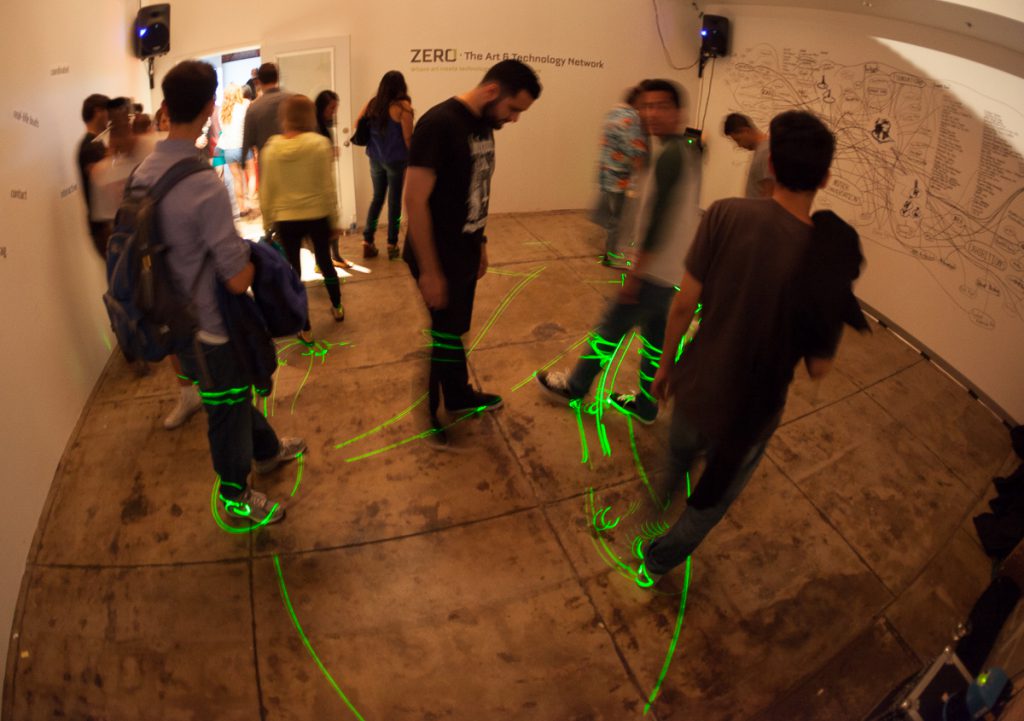
Co-related Space is a digitally-enhanced environment that immerses participants not in digital space, but embodied space, highlighting the spatiality of participants, their behavior and their relationships with others within that space. Using motion tracking, laser light projection and a generative soundscape, it encourages interactions between participants, visually and sonically transforming a regularly trafficked space. Co-related Space highlights participants’ active engagement and experimentation with sound and light, including complex direct and indirect behavior and relationships.
The key to Co-related Space is a sophisticated visual tracking system combined with complex data aggregation. The system observes people’s movements over time, including moving fast or slow, dancing, standing close, hugging, and synchronizing their movement. Visually and sonically, these observed and inferred behaviors are highlighted with sound and light.
Visually, the piece sketches laser lines around and between participants with the thickness, quality, and dynamics of the lines determined by the nature of their participation and the relationships between them. In Co-related Space, sound, light, and your fellow participants are everything. Sonically, the piece draws inspiration from ambient sound, developing the complexity and dynamism of each participant’s sonic “voice” as they interact within the space.
A conductor subsystem leads the piece through a series of subtle movements. The nature of the piece remains the same, but some of the details change. For instance, perhaps only the most active participants are highlighted, or perhaps only the most quiescent. Perhaps, in one movement, the piece creates a connector between people who have no connection already, encouraging interactions between strangers.
Co-related Space is an innovative new media work. Each of the major systems of the piece — the playful laser light sketches, the high-tech motion tracking system, and the generative musical soundscape — break new technical ground. However, the real joy of Co-Related Space will be watching children and grown-ups playfully moving through the space and with each other in response to the dance of light and sound.
The installation will be available to be sited in public spaces, at festivals and events, and in gallery settings. The debut of Co-related Space will be at the Digital Art and New Media Open Studios, University of California Santa Cruz on Juen 6th, 2014. In October, it will appear as part of the Santa Cruz Museum of Art and History’s GLOW Fire Festival. We are negotiating with the San Jose Tech Museum of Innovation for an extended summer 2014 exhibition.
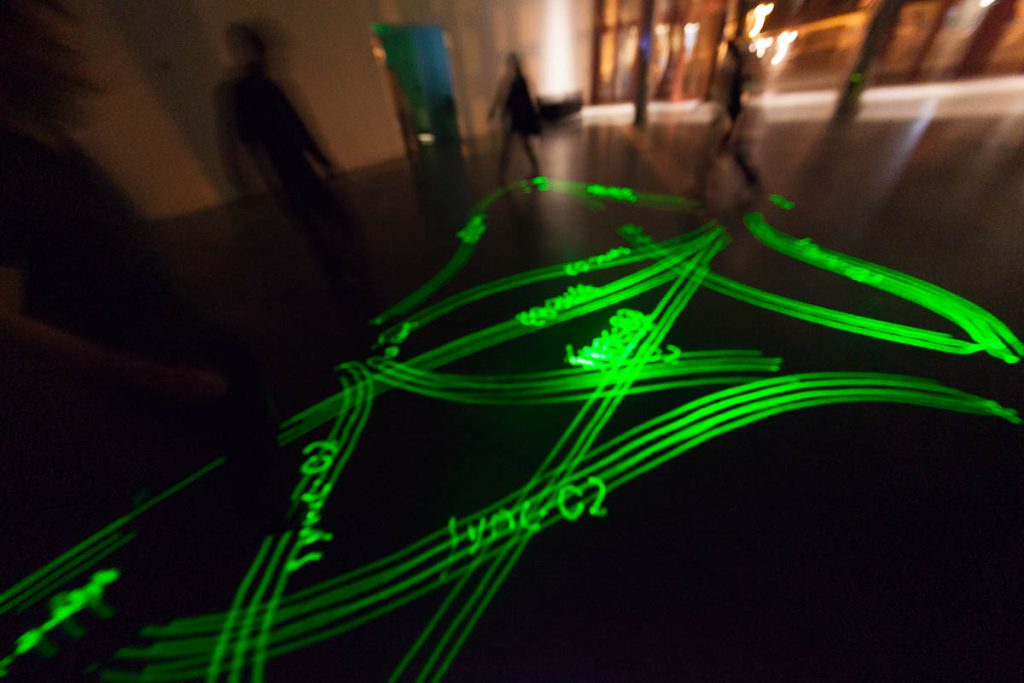
Forms and Materials
Visually, Co-related Space will create a playful synthesis with the aural components. Using a white laser projector coordinated with motion tracking sensors, the piece will represent its current analysis of the state of the location space and the presence of participants within it. For instance, the piece will sketch lines around and between participants with the thickness, quality, and dynamics of the lines determined by the nature of their participation and the real and symbolic relationships between them (Figures 1 and 3). The piece was partly inspired by and, in terms of line style and variation, takes on some of the visual character of Robert Henke’s Fragile Territories (Figures 4 and 5).
Sonically, Co-related Space provides participants with distinct musical instruments that respond to movement within the space and to interactions with other participants. With increasing engagement, a participant’s voice will expand its gamut, develop a more complex timbre, gain dynamic range, and achieve spatial independence. The most active participants will achieve the ability to control a responsive and flexible instrument. Participants’ musical voices will be accompanied by a musical ground, which provides context for and continuity to the sonic experience. The sound will be realized across four channels.
Physically, the piece remains invisible, working hard not to call attention to itself while highlighting the behavior and interaction of the participants. Speakers, sensors, audio equipment, and projection equipment will remain as hidden as possible. Through its audio and visual responses, the work acknowledges presence in a space in a way that unobtrusively rewards immersion in its interactive environment.
Still from Robert Henke’s Fragile Territories.
Still from Robert Henke’s Fragile Territories.
Space Requirements
Co-related Space is designed to be located in a space through which people regularly pass, but which is not populated too densely. The artists envision the installation in a darkened lobby, a gallery, or a similar space. An ideal space is 30 foot square with very high ceilings, low intensity lighting, sonically semi-isolated from other sound, and facilitates the discrete placement of speakers, sensors, projector, and other equipment. However, the piece has the flexibility to adapt to different locations.
Dimensions: Co-related Space requires an indoor space with a minimum small dimension of 20 feet (6 meters) and a maximum large dimension of 60 feet (18 meters). High ceilings at least 30 feet (9 meters) are important for safety as well as well as ability to cover the full floor.
Lighting: Dim lighting is preferred.
Sound: Piece requires a sonically isolated space. It doesn’t have to be silent, but on the quiet side of the loud-silent spectrum is preferred.
Exhibitions
Here are the past exhibit dates for Co-related Space.
| Date | Exhibition |
| May 21-June 7, 2015 | San Francisco International Art Festival, Ft. Mason, San Francisco, California |
| October 18, 2014 | GLOW Festival of Fire at Santa Cruz Museum of Art & History, Santa Cruz, California |
| September 20, 2014 | Anne & Mark’s Art Party at the Santa Clara County Fairgrounds, San Jose, California |
| June 6-7, 2014 | Leonardo Art Science and Tech Festival at Zer01 in San Jose |
Our debut exhibition will be at UCSC Spring Open Studios, a free event open to the entire community and promoted vigorously on-campus and throughout the wider off-campus community. Our primary exhibition will be at the GLOW Fire Festival at the Museum of Art and History, an event that draws 4000 people annually from a wide demographic. Currently, we are talking to the San Jose Tech Museum of Innovation about an extended summer 2014 exhibition as part of The Digital Music Temporary Exhibition, a planned six-month program featuring interactive music and audio-related installations.
References
- Carroll, J. J., Coover, R., Greenlee, S., McClain, A., & Wardrip-Fruin, N. (2003). Screen: bodily interaction with text in immersive VR. doi:10.1145/965400.965533
- Davies, C. (2004). Virtual Space. In F. Penz, G. Radick and R. Howell (Ed.), Space: In Science, Art and Society (pp. 69-104). Cambridge: Cambridge University Press.
- Hart, P. E.; Nilsson, N. J.; Raphael, B. (1968). “A Formal Basis for the Heuristic Determination of Minimum Cost Paths”. IEEE Transactions on Systems Science and Cybernetics SSC4 4 (2): 100–107. doi:10.1109/TSSC.1968.300136.
- Henke, R. (2012). Fragile Territories. Retrieved from http://roberthenke.com/installations/fragile_territories.html
- International Commission on Non-Ionizing Radiation Protection (2013). ICNIRP GUIDELINES ON LIMITS OF EXPOSURE TO LASER RADIATION OF WAVELENGTHS BETWEEN 180 nm AND 1,000 μm. HEALTH PHYSICS,105(3), 271‐295.
- Laurel, B., Strickland, R., & Tow, R. (1994). Placeholder: landscape and narrative in virtual environments. ACM Siggraph Computer Graphics. doi:10.1145/178951.178967
- LVR Optics (2013). LVR Blog – Changes to Laser MPE Limits. Retrieved from http://www.lvroptical.com/blog_MPE_limits.htm
- McRobert, L. (2007). Char Davies’ immersive virtual art and the essence of spatiality. Toronto: University of Toronto Press.
- Modes, W. (2014). Revisiting the Technical Achievements of Listening Post Ten Years On. NMEDIAC, 9(1). Retrieved from http://ibiblio.org/nmediac/winter2014/Articles/ListeningPost.html
- Murphy, P., & Makhov, G. (2012, August 20). Scanning Audiences at Laser Shows: Theory, Practice and a Proposal. Retrieved from http://www.laserist.org/files/audience-scanning_overview_latest.pdf
- Townshend, B. (2013). Pulsefield. Retreived from http://artlib.com/pulsefield/
- US Food and Drug Administration (2013, April 21). CFR – Code of Federal Regulations Title 21. Retrieved from http://www.accessdata.fda.gov/scripts/cdrh/cfdocs/cfcfr/CFRSearch.cfm?FR=1040.11
- US Food and Drug Administration (1992, June). COMPLIANCE GUIDE FOR LASER PRODUCTS (HHS Publication FDA 86-8260). Retrieved from http://www.fda.gov/downloads/MedicalDevices/DeviceRegulationandGuidance/GuidanceDocuments/UCM095304.pdf
Support
Supported in part by a generous grant from:
